When people think of visiting WWII sites on Oahu, they probably don’t get much farther than Pearl Harbor. And while I’m definitely going to talk about the many amazing Pearl Harbor sites in this post, I’m also going to point out several more you should visit the next time you’re in Hawaii.
The Japanese attack on Pearl Harbor launched the U.S. into war, and throughout the rest of it the island of Oahu stood on alert. As a result, there are tons of WWII sites on Oahu – museums, defense ruins, crash sites, cemeteries, and many more. Here are the 24 Oahu WWII sites you should consider adding to your travel itinerary.
Map of WWII sites on Oahu
This map contains all the WWII sites on Oahu I mention in this post. To save this map: Click on the star ⭑ next to the map’s title to save in your Google Maps. To use this map: When you get there, open Google Maps on your phone, click “Saved” at the bottom, then click “Maps.”
Pearl Harbor WWII sites on Oahu
I talk about all of these in depth in my many posts about Pearl Harbor, so I’m just going to briefly summarize them here. For more details, please click that link above to dig into all my Pearl Harbor content.
1. Pearl Harbor Visitor Center
The Pearl Harbor Visitor Center is the main hub for visiting Pearl Harbor and the home base of the Pearl Harbor National Memorial (and National Park site).
Besides the usual “visitor center” stuff, there’s also a couple of Pearl Harbor museums, a memorial theater that shows a great documentary, and a gift shop. This is also where you board the boat to visit the USS Arizona Memorial.
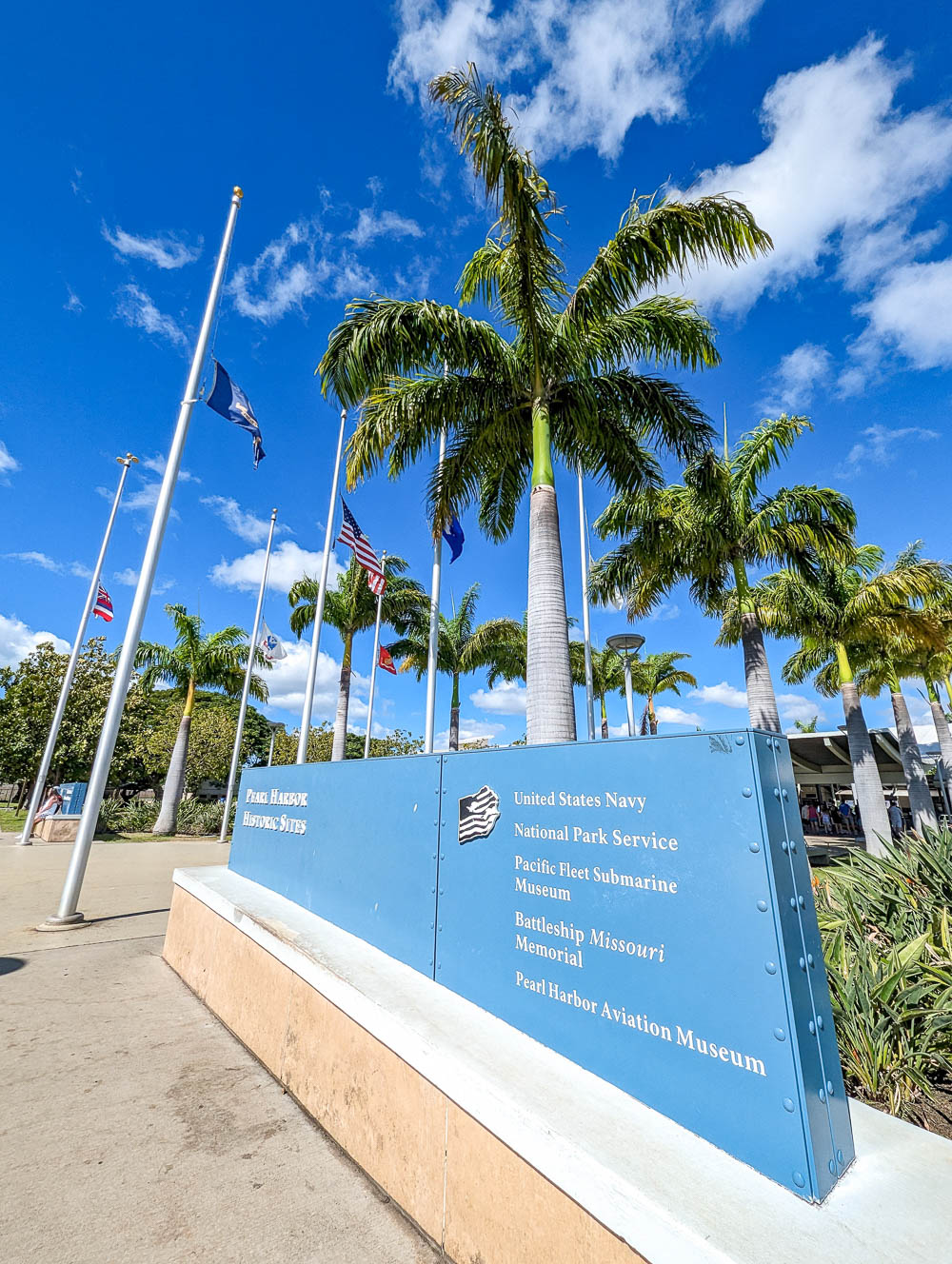
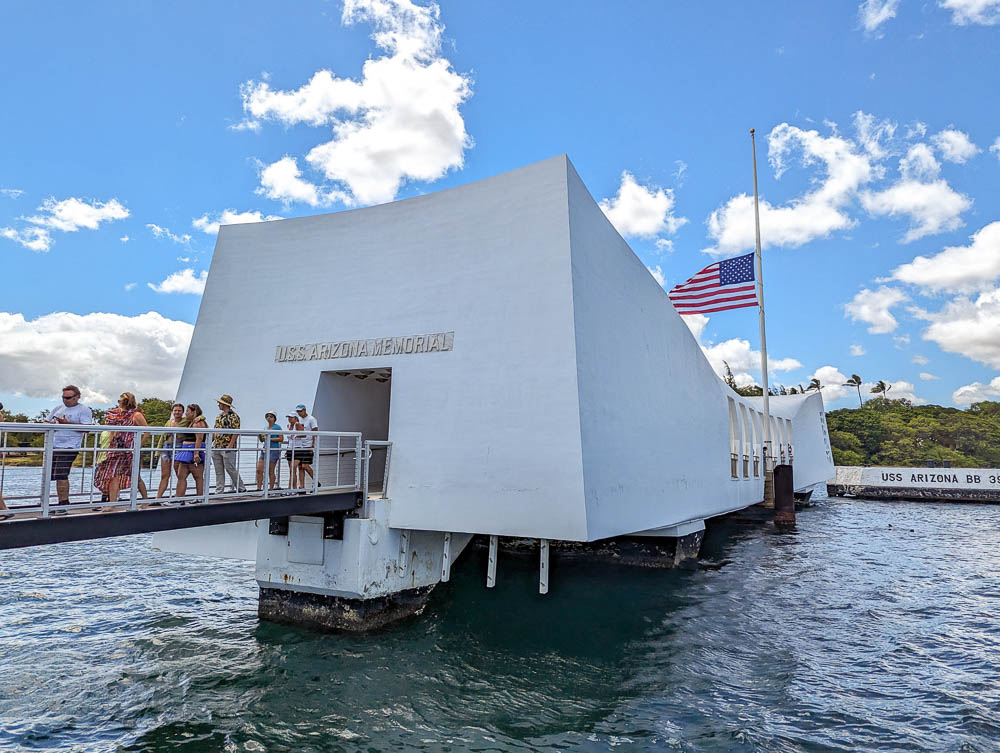
2. USS Arizona Memorial
This is the site people most think of when they think about “visiting Pearl Harbor.” This memorial sits over the sunken remains of the USS Arizona, a battleship the Japanese sunk during the Pearl Harbor attack and where 1,177 men died as a result.
3. Pacific Fleet Submarine Museum
Next door to the Visitor Center is the Pacific Fleet Submarine Museum (also known as the Bowfin Museum). It’s the home of the USS Bowfin, a WWII-era submarine, as well as an indoor museum and large collection of outdoor artifacts, all telling the story of submarine warfare.
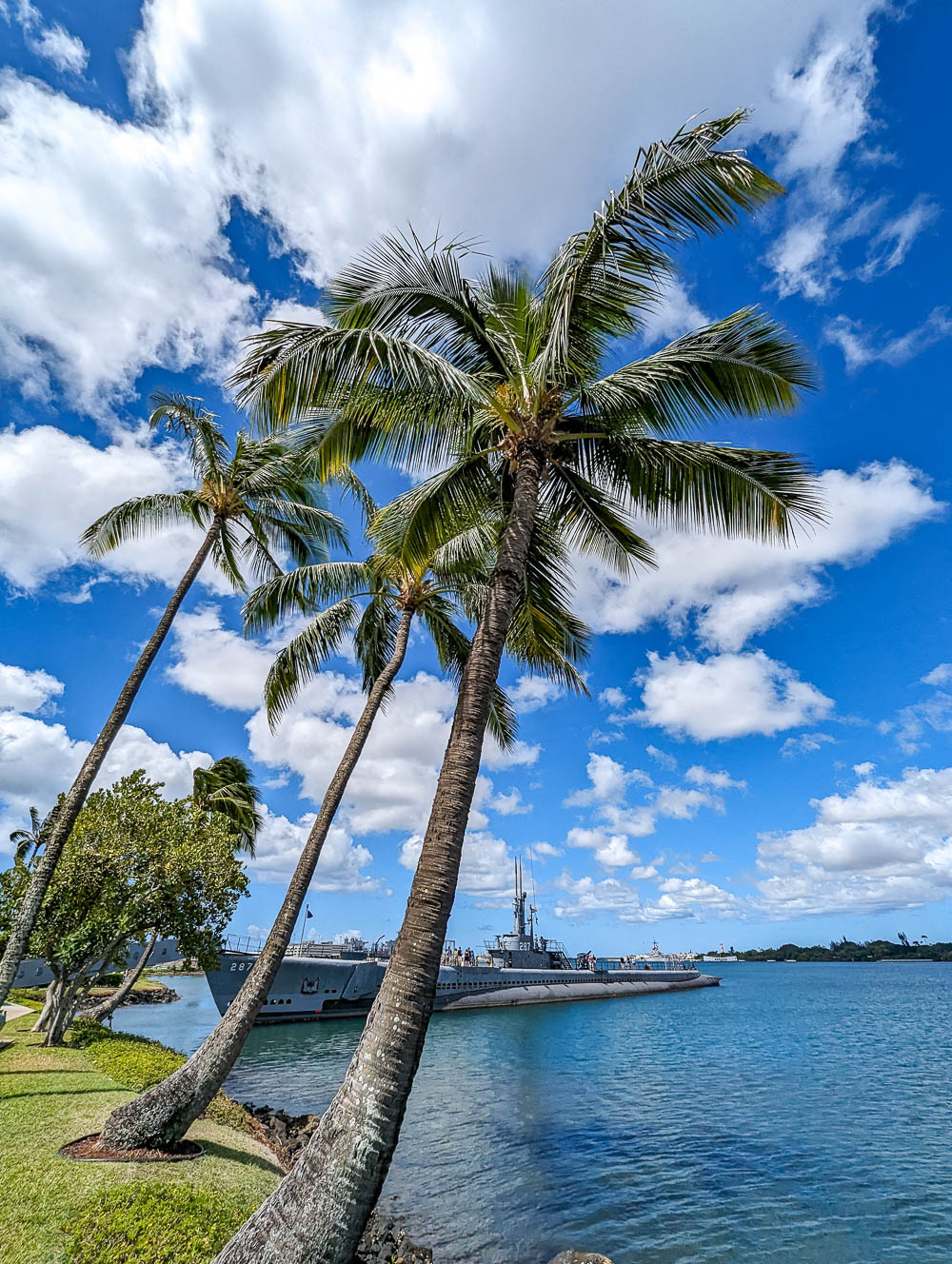
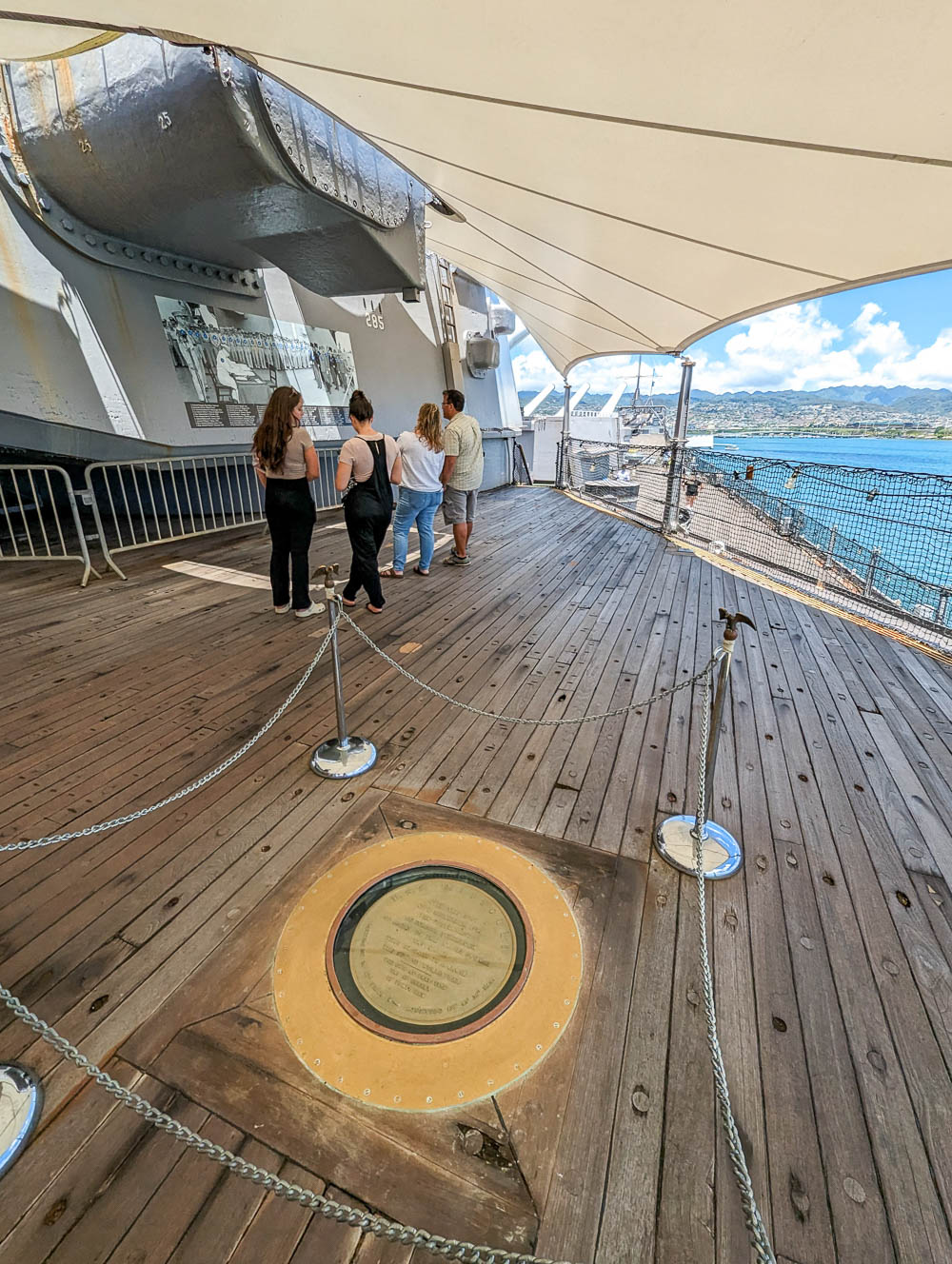
4. Battleship Missouri
The USS Missouri was a WWII-era battleship that not only saw service in the Pacific but also served as the location for the surrender ceremony that ended World War II. It was on the main deck of this ship that Japan officially surrendered to the U.S. You can take guided tours of the ship as well as explore it on your own.
5. Pearl Harbor Aviation Museum
Near the Battleship Missouri is the Pearl Harbor Aviation Museum which focuses on the “air” portion of the Pearl Harbor attack, since the Pearl Harbor attack was, by and large, an air raid. Check out their fantastic collection of WWII-era aircraft, visit the famous hangars, and take an unforgettable tour atop the Ford Island Control Tower.
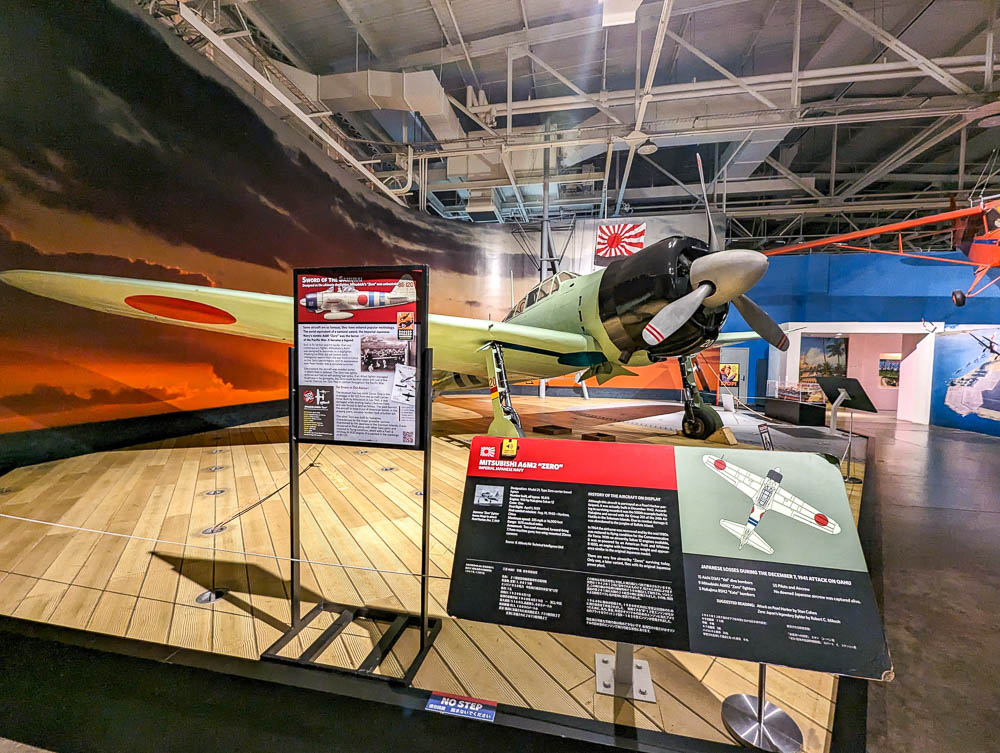

6. USS Oklahoma Memorial
Outside the entrance to the Missouri is the USS Oklahoma Memorial. This memorial honors the 429 men who died aboard the USS Oklahoma when Japanese fighters sunk it on December 7, 1941.
7. Ford Island Historic Trail (military access only)
If you have military access, you can explore the Ford Island Historic Trail, a walking trail around Ford Island that stops at many historically-notable spots. You’ll see tons of memorials, original buildings, and even some strafing marks from Japanese machine guns that still remain here.
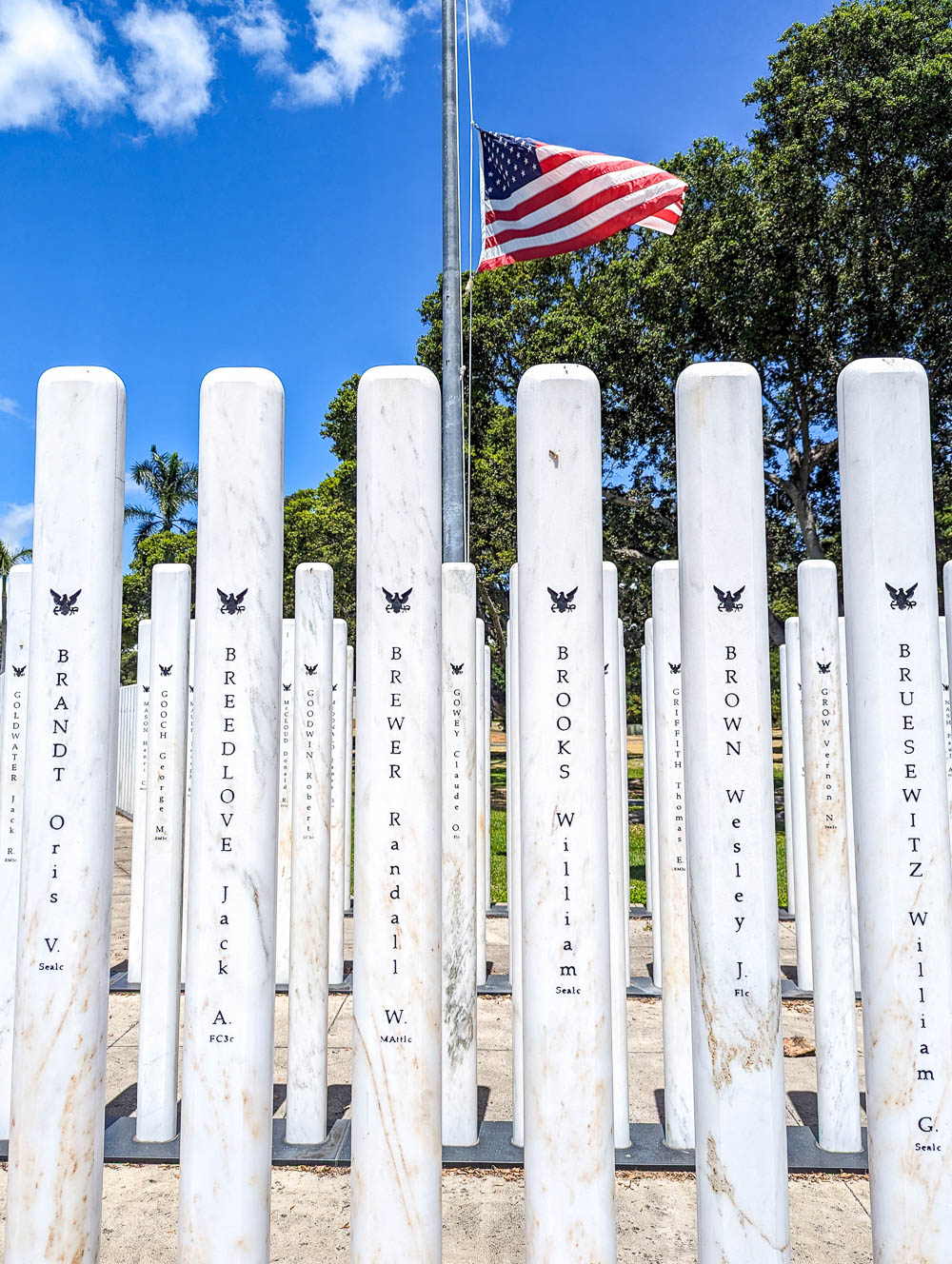
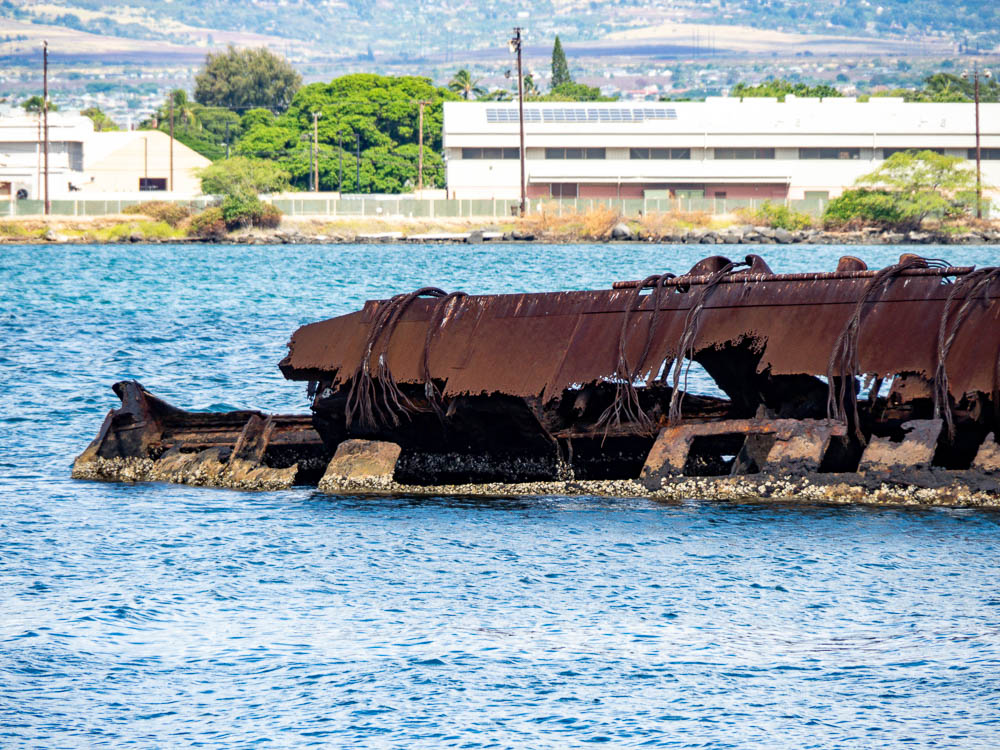
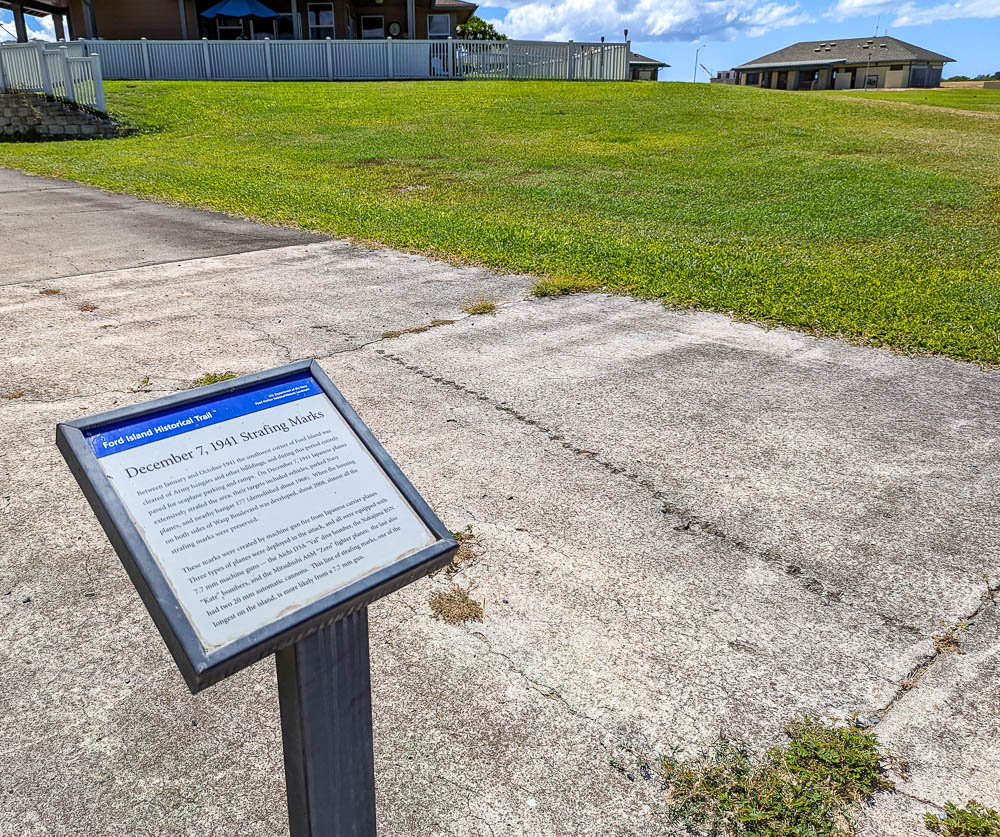
8. USS Utah Memorial (military access only)
While on Ford Island, also check out the USS Utah Memorial which honors the 58 men who died when it was sunk during the Pearl Harbor attack. You can still see much of the rusted ship sticking out of the water.
This was a super brief summary of what the Pearl Harbor sites are all about, but there’s really so much more to learn about them. Check out my Pearl Harbor page or pick up one of these great Pearl Harbor books to learn more.
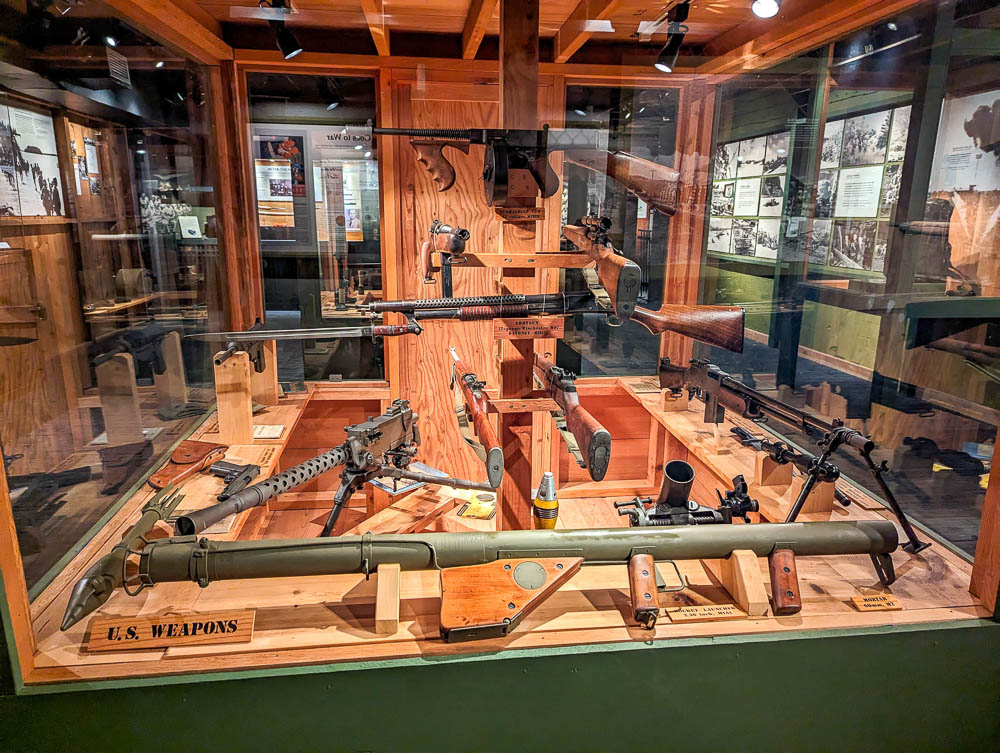
Oahu WWII sites: Museums
In addition to the museums at Pearl Harbor, here are two more great World War II museums worth visiting on Oahu:
9. US Army Museum of Hawaii
This free museum is located at Fort DeRussy, inside Battery Randolph, a former coastal artillery fortification. (You can still check out the guns mounted in their original spots.) This museum covers the entire timeline of the U.S. Army here in Hawaii, but for obvious reasons a great deal of it still focuses on the WWII-era.
Given how crowded and hot Pearl Harbor can be, I found this to be a much more enjoyable place to learn about the Pearl Harbor attack and see some awesome artifacts. They do a great job of making the information easily understandable and relatable.
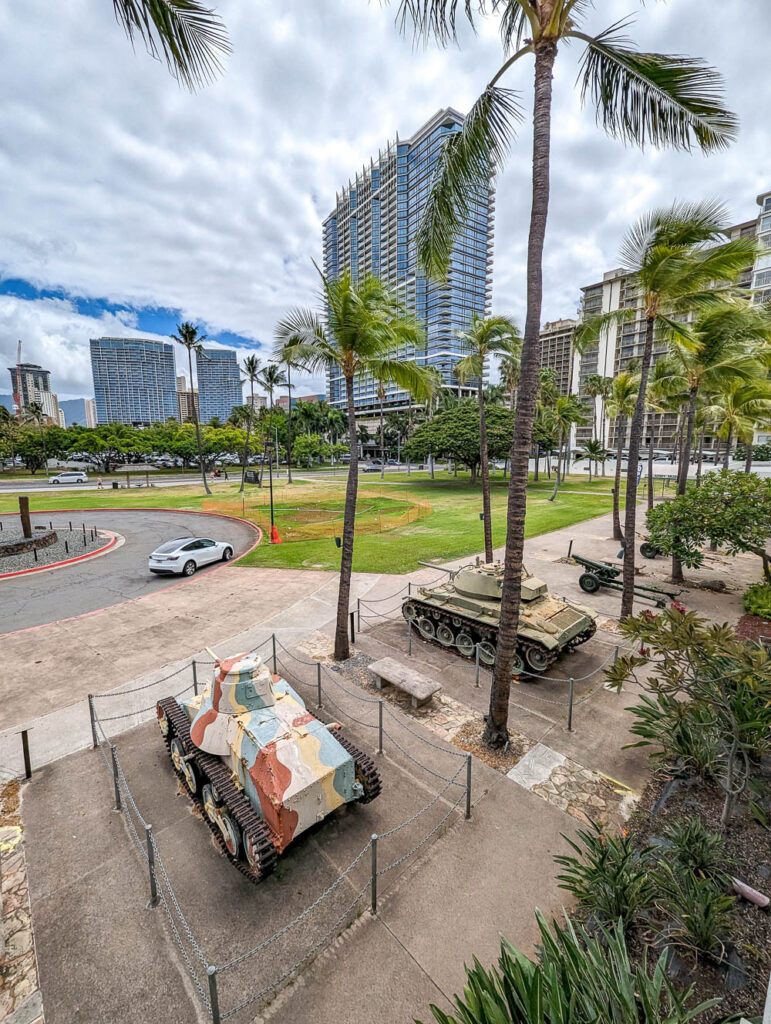

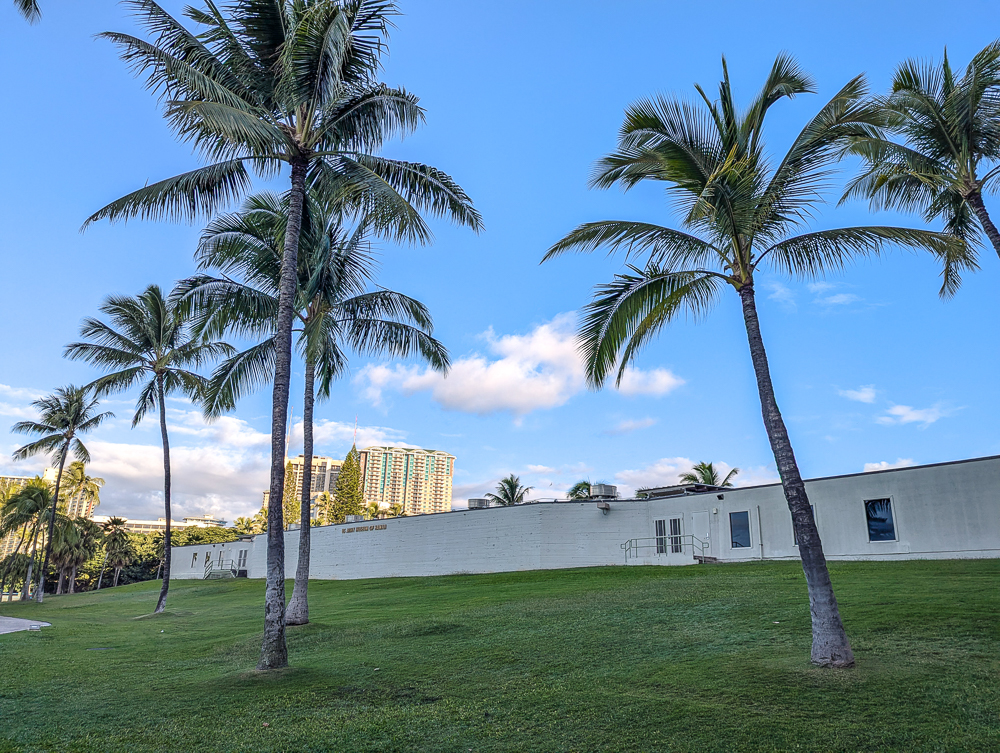
Out front there’s a large collection of WWII tanks and other vehicles. Inside, you’ll also find the “Gallery of Heroes” which honors recipients of the Medal of Honor and the Distinguished Service Cross (or the Navy or Air Force Cross.)
This museum is free to visit and they even validate parking in the lot across the street. Get more information on the U.S. Army Museum of Hawaii here.
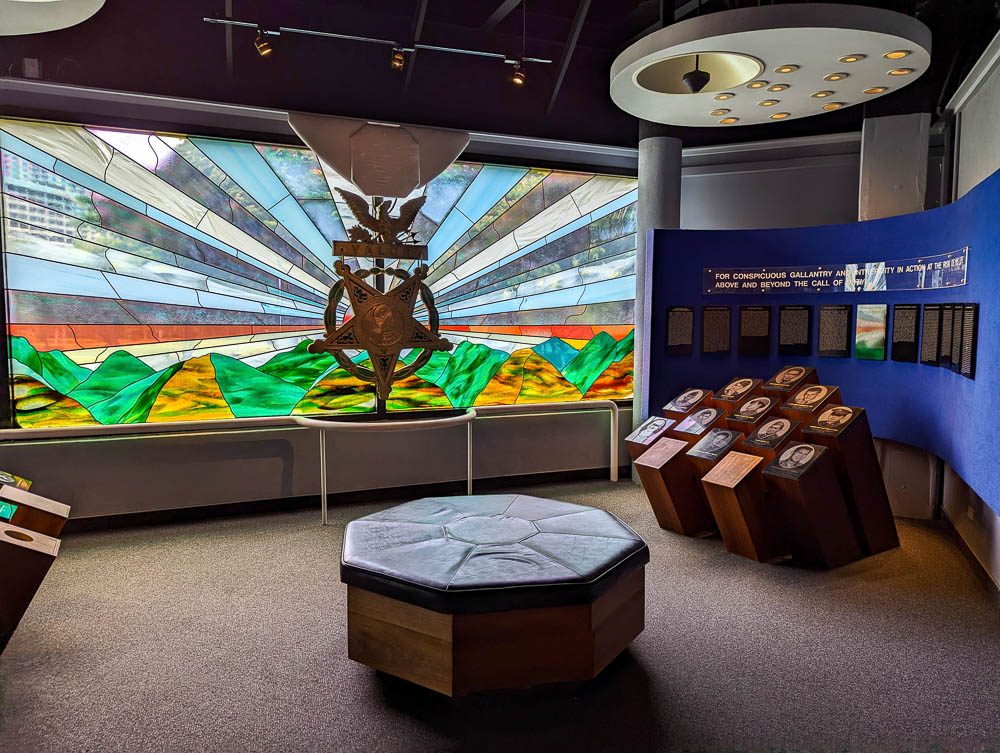
10. Tropic Lightning Museum
The Tropic Lightning Museum is dedicated to the work of the 25th Infantry Division in the Pacific theater and the histories of Wheeler Army Airfield and Schofield Barracks, where the museum is located.
Seeing as how this museum is located on an active military base, be sure to have your photo ID and car registration and insurance information available. (Or rental car agreement if you’re visiting.) Get more info on the visitor requirements here.
One of the most popular WWII sites on Oahu—the Brewseum—was a combination WWII museum and taproom and a favorite of many. That is, until it closed permanently in 2020. They have since relocated to Durango, Colorado where you’ll soon be able to visit the all-new Home of the Brave Museum & Brewseum. You can check their website for updates here.
11. Nisei exhibit at the Honolulu airport
If you find yourself passing through the international terminal of Honolulu’s Daniel K. Inouye airport, definitely take some time to check out the permanent museum exhibit courtesy of the Nisei Veterans Legacy. (Located near gate 56.)
This exhibit contains tons of information and historical artifacts on Japanese Americans who served in the armed forces during WWII. This includes the 100th Infantry Battalion, the 442nd Regimental Combat Team, and the 1399th Engineer Construction Battalion.
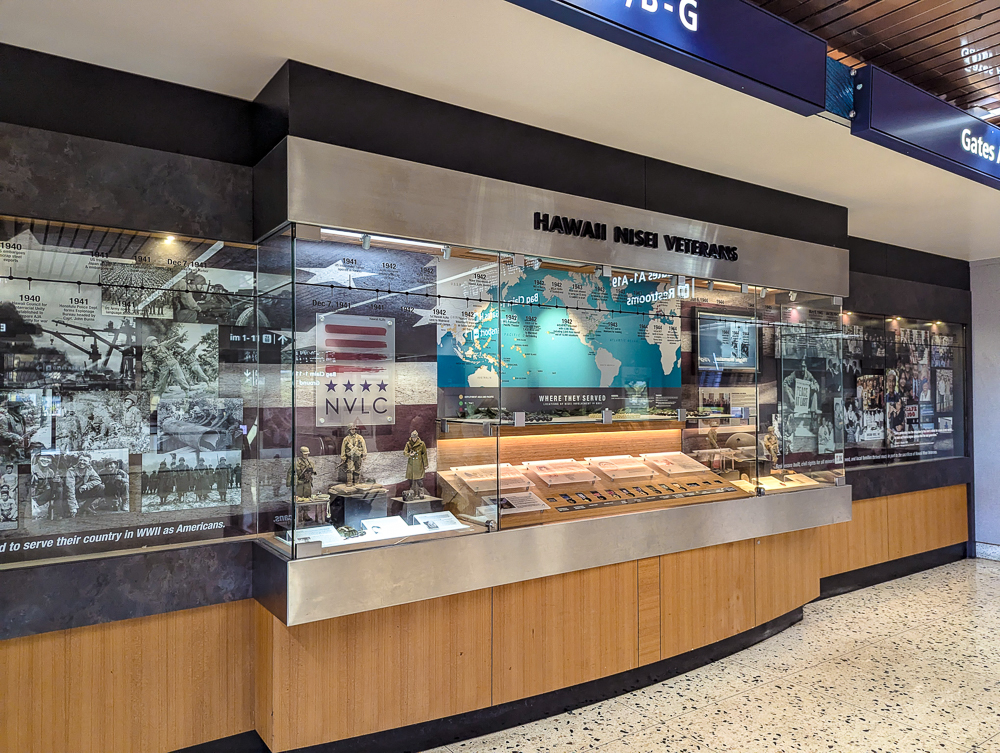
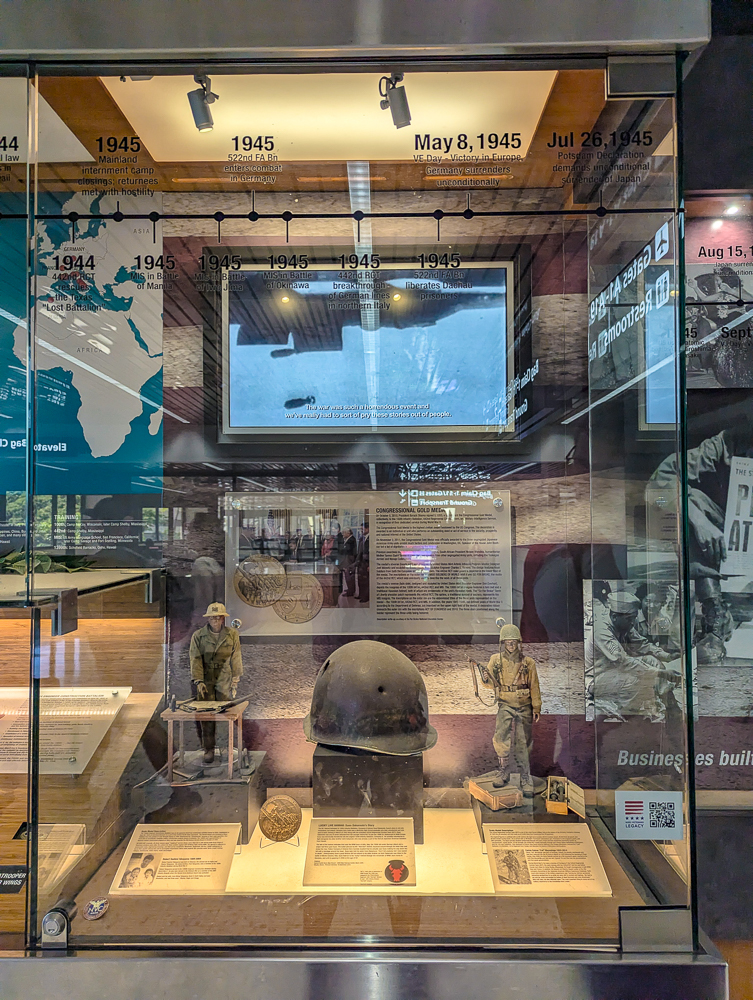

Oahu WWII sites: Cemeteries
While on Oahu, pay can your respects to those who gave their lives in World War II at these cemeteries:
12. National Memorial Cemetery of the Pacific (Punchbowl Cemetery)
Just outside downtown Honolulu you’ll find the National Memorial Cemetery of the Pacific (commonly referred to as ‘Punchbowl Cemetery’ due to its location within the Punchbowl Crater).
This massive burial and memorial site opened in 1949 and contains the graves of those who died serving in the U.S. military in the Pacific (both in WWII and the Korean War, and now the Vietnam War also). Along with dozens of WWII Medal of Honor recipients and hundreds of unidentified Pearl Harbor victims, civilian war correspondent Ernie Pyle is also buried here.
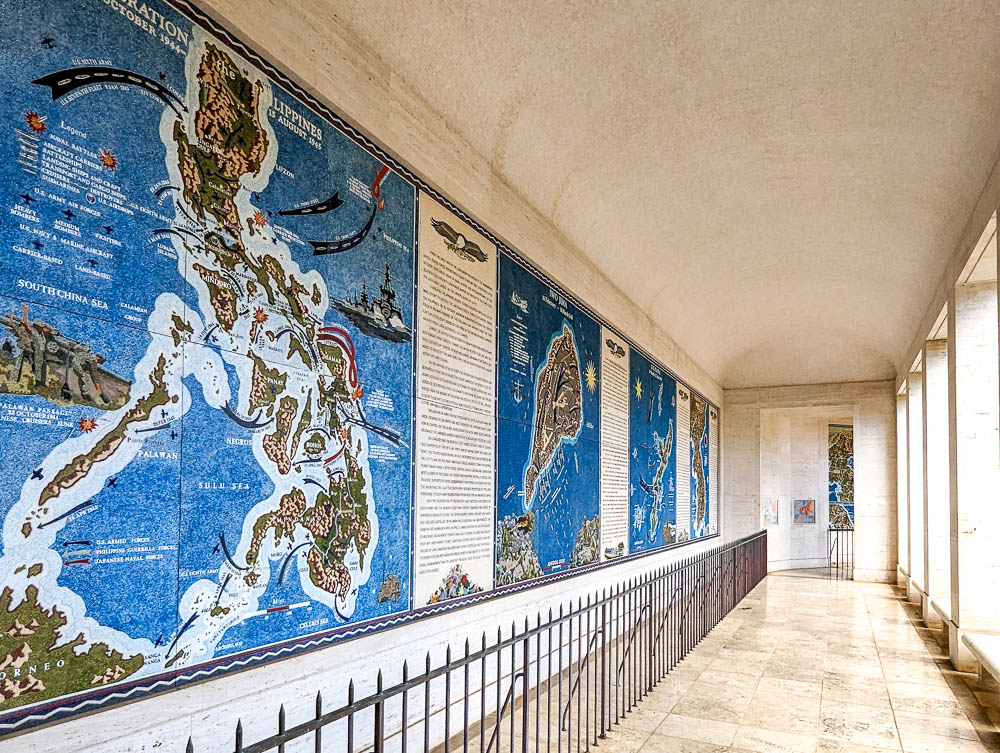

In addition to the burial sites, this cemetery also contains a grand memorial atop a massive hill. This memorial includes huge mosaic maps that detail the biggest military achievements of the Pacific war, large walls that feature the names of the missing (18,095 of them from WWII alone), and a memorial chapel. There are also several smaller World War II memorials scattered throughout the cemetery.
You can find all the visitor information you need for the Punchbowl Cemetery here.
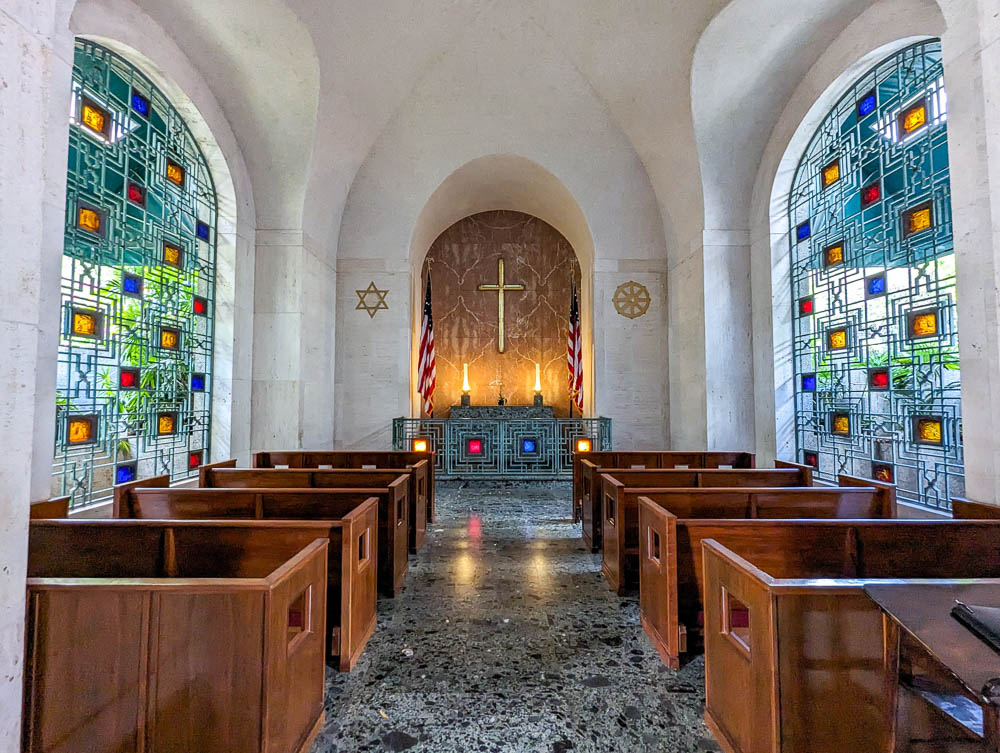
13. Hawaii State Veterans Cemetery
Across the island in Kaneohe you’ll find the Hawaii State Veterans Cemetery. It opened in 1991 and contains the graves of about 10,000 Pacific war veterans from World War II, the Korean War, and others. They also host regular Memorial Day ceremonies. Visitor information here.
14. Oahu Cemetery
Oahu Cemetery in Honolulu contains three Commonwealth graves; all of them were from the UK, worked aboard the HMS Victorious, and died in April 1943.
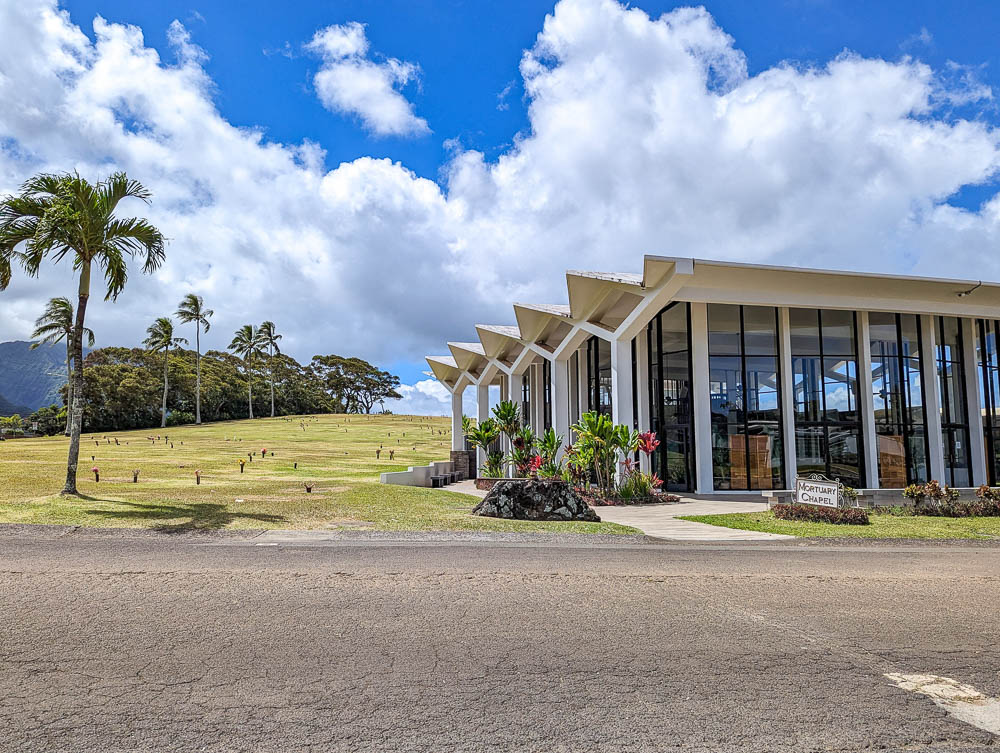
Oahu WWII sites: Memorials
Besides the many memorials at Pearl Harbor and in the cemeteries, you can also find several World War II memorials around the island of Oahu. Here are a few to keep your eyes peeled for:
15. Haleiwa Beach Park War Memorial
If you’ll find yourself up on the North Shore in historic Haleiwa, be sure to stop by the memorial at Haleiwa Beach Park. There’s free parking all around it and easy beach access. (And probably a sea turtle or two waiting for you.)
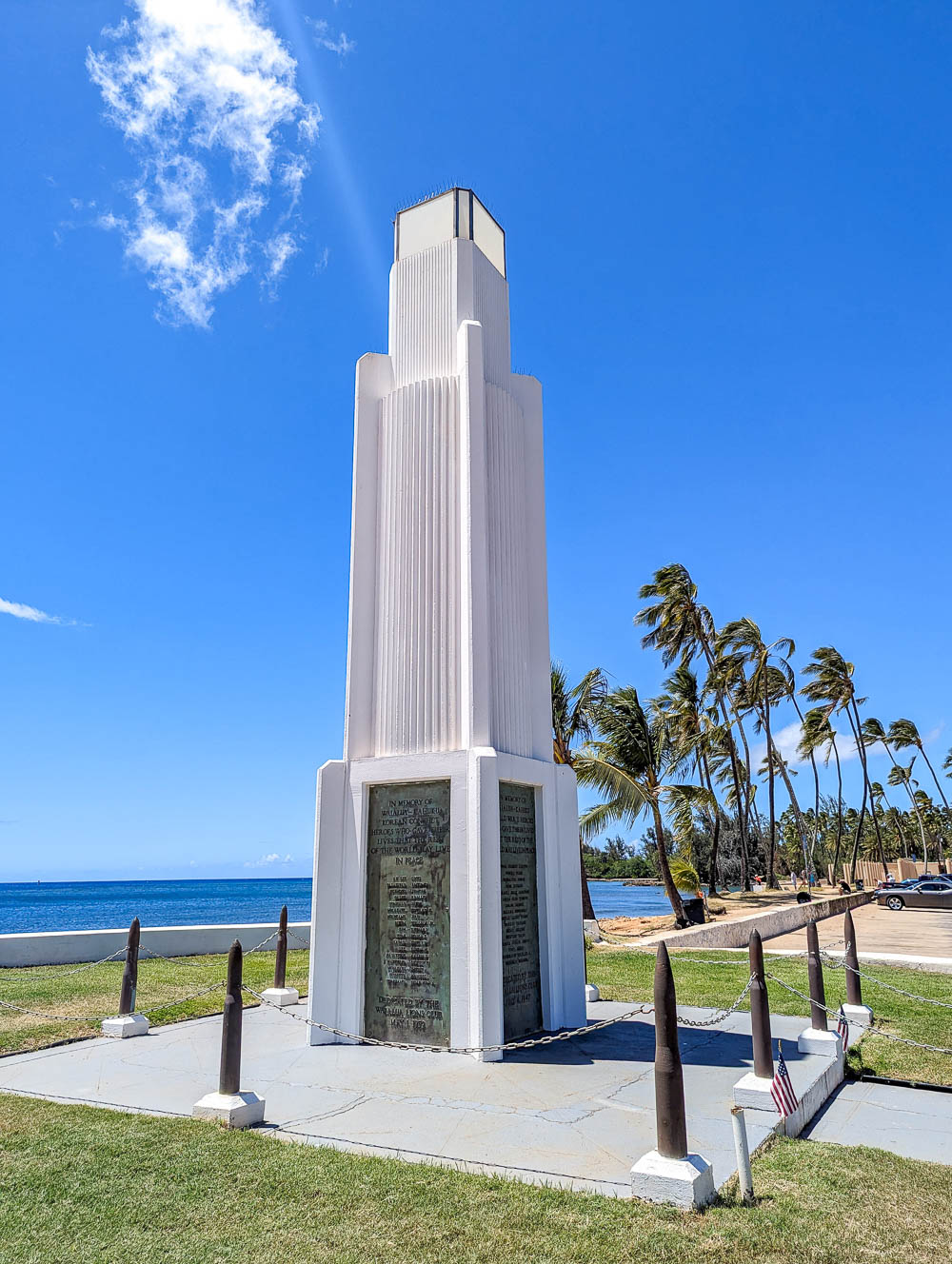
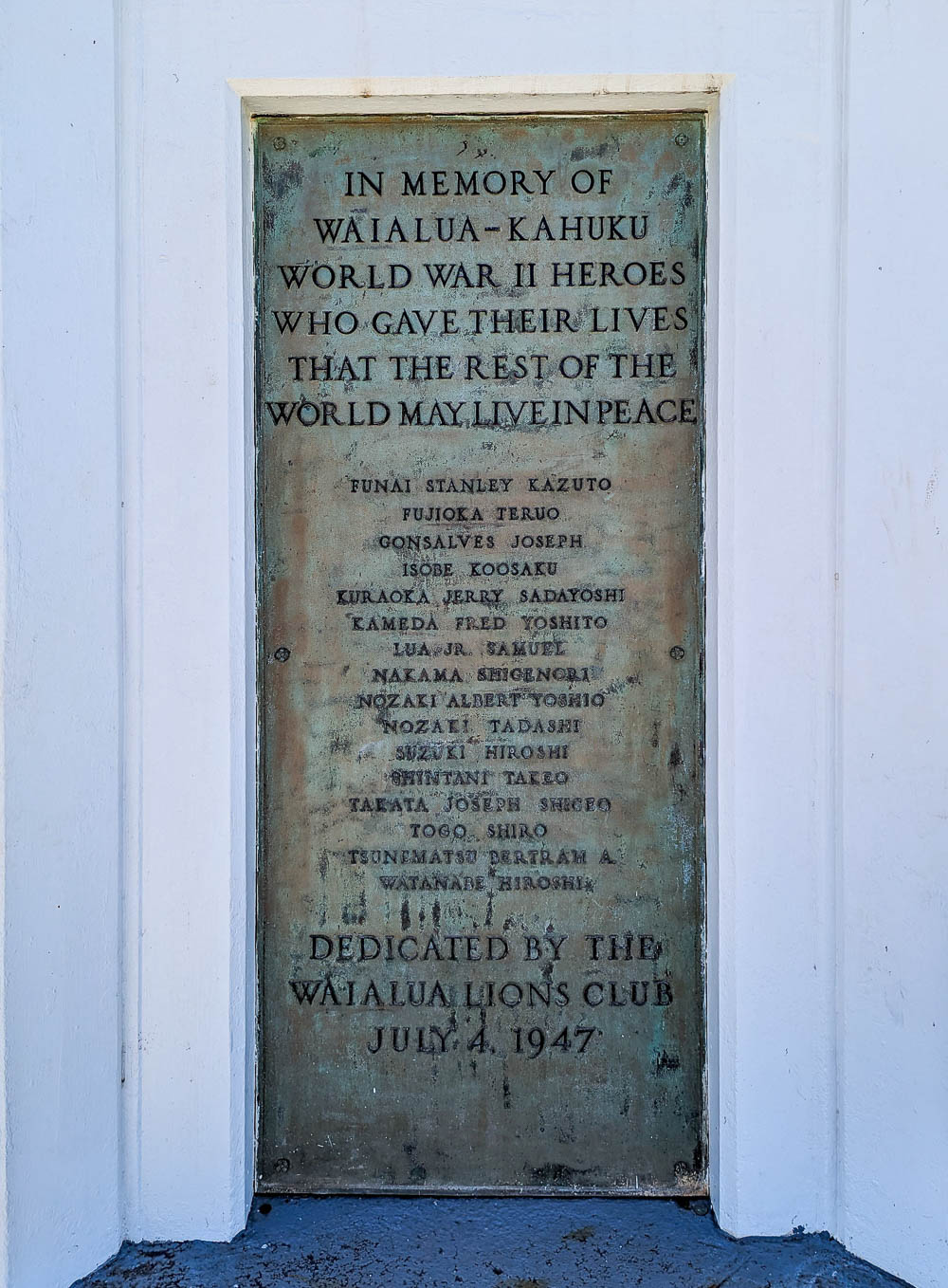
16. Pacific War / Iwo Jima Memorial (military access only)
For those of you with military access, head over to the Marine Corps Base Hawaii in Kaneohe to check out the Pacific War Memorial—probably more familiar to you as a replica of Joe Rosenthal’s Iwo Jima flag raising memorial. Though a little different from than the original in Arlington, Virginia, the sentiment is the same—a celebration of Allied victory in the Pacific and a memorial to lives lost. It’s surrounded by a “Walkway of Honor.”
Because this memorial is located on an active military base, you do need military access to see it. (It’s located just inside the main gate to the left.) More information here.
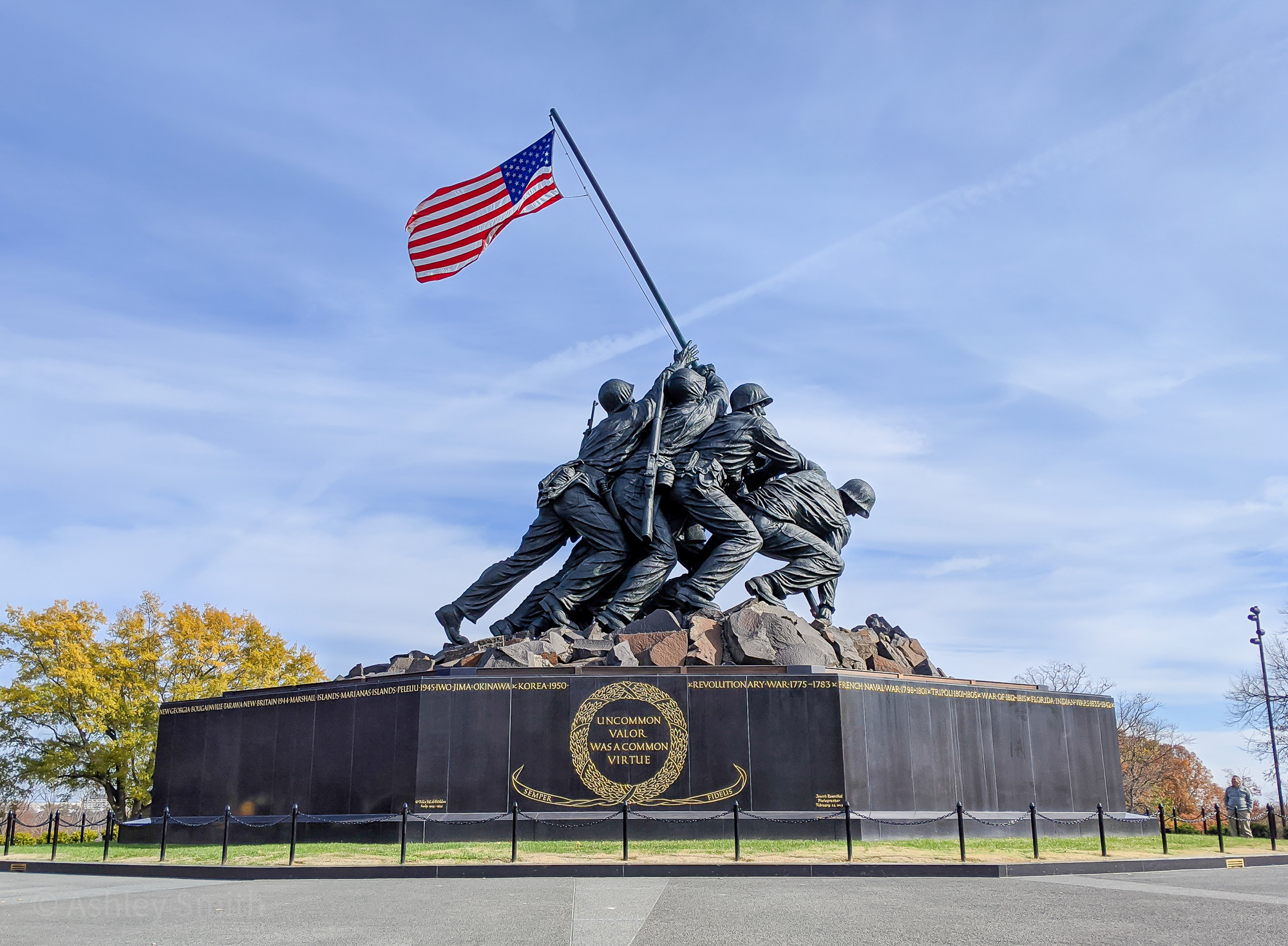
17. Eternal Flame of the Armed Forces at the State Capitol
Outside the state capitol building in Honolulu stands the Eternal Flame of the Armed Forces. It was erected in 1972 to honor the victims of the Pearl Harbor attack as well as all men and women from the state of Hawaii who have served in the armed forces of the United States.
It was designed by Hawaiian sculptor and veteran Bumpei Akaji who fought in Italy in 1943 with the 100th Battalion of the 442nd Regimental Combat Team. This memorial was dedicated in 1972 and replaced an earlier memorial which was moved to Kee’hi Lagoon.
18. Kee’hi Lagoon Memorial
Established in 1949, the Kee’hi Lagoon Memorial is actually a large memorial park, the centerpiece of which is the memorial obelisk, “dedicated to the living, in memory of our fallen comrades who gave their lives to our country” in the Pacific theater during World War II. More information here.
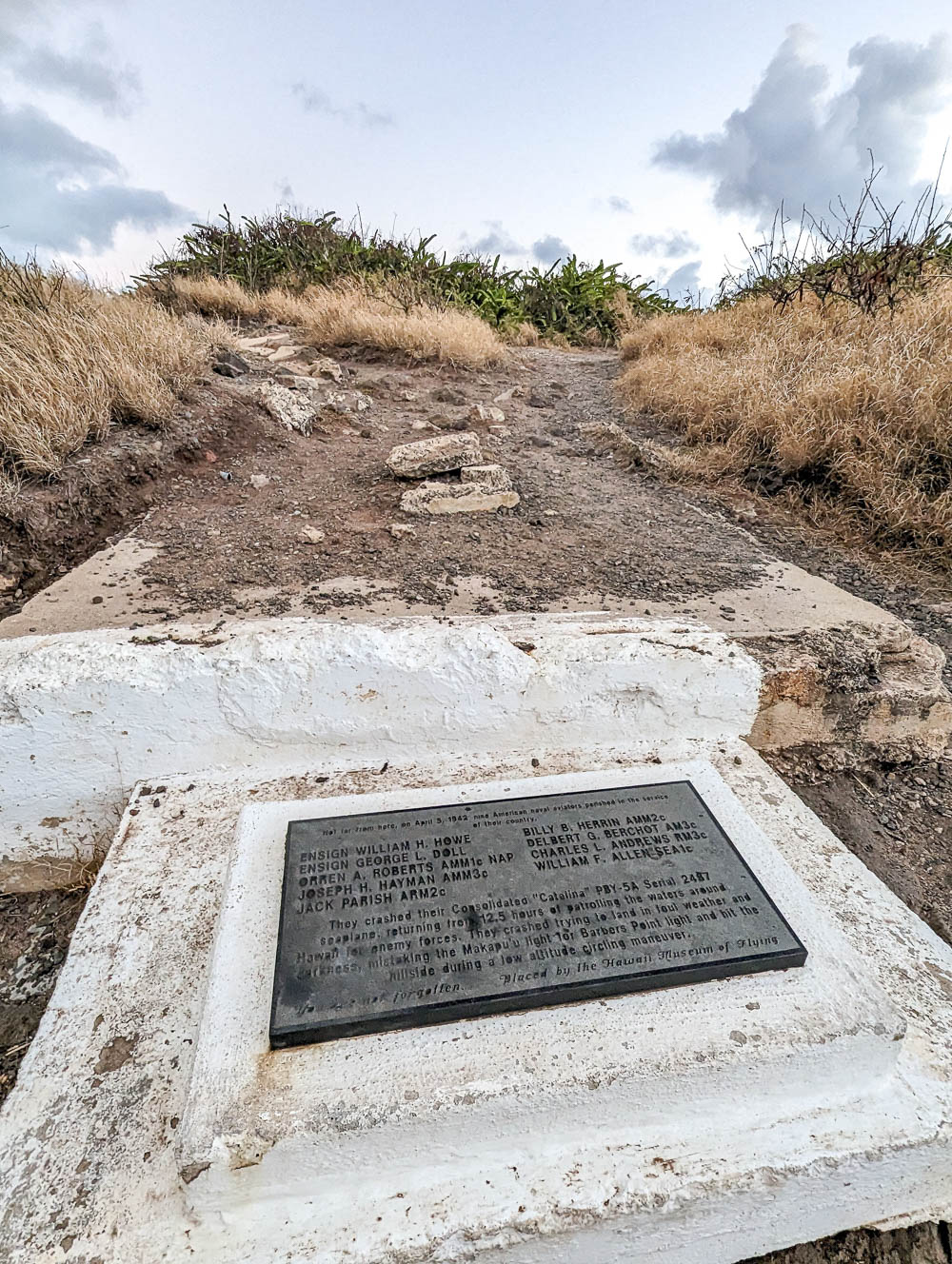
19. Catalina crash site memorial
Up on the top of Makapu’u Point you’ll find a memorial dedicated to those killed in a plane crash near this spot in 1942. To get to this memorial, you’ll need to hike up the Makapu’u Lighthouse Trail (full guide in that link). This is an easy and incredibly worthwhile hike, especially at sunrise.
As the memorial states:
Not far from here, on April 5, 1942, nine American naval aviators perished in the service of their country.
They crashed their Consolidated “Catalina” PBY-5A Serial 2487 seaplane, returning from 12.5 hours of patrolling the waters around Hawaii for enemy forces. They crashed trying to land in foul weather and darkness, mistaking the Makapu’u light for Barbers Point light and hit the hillside during a low altitude circling maneuver.
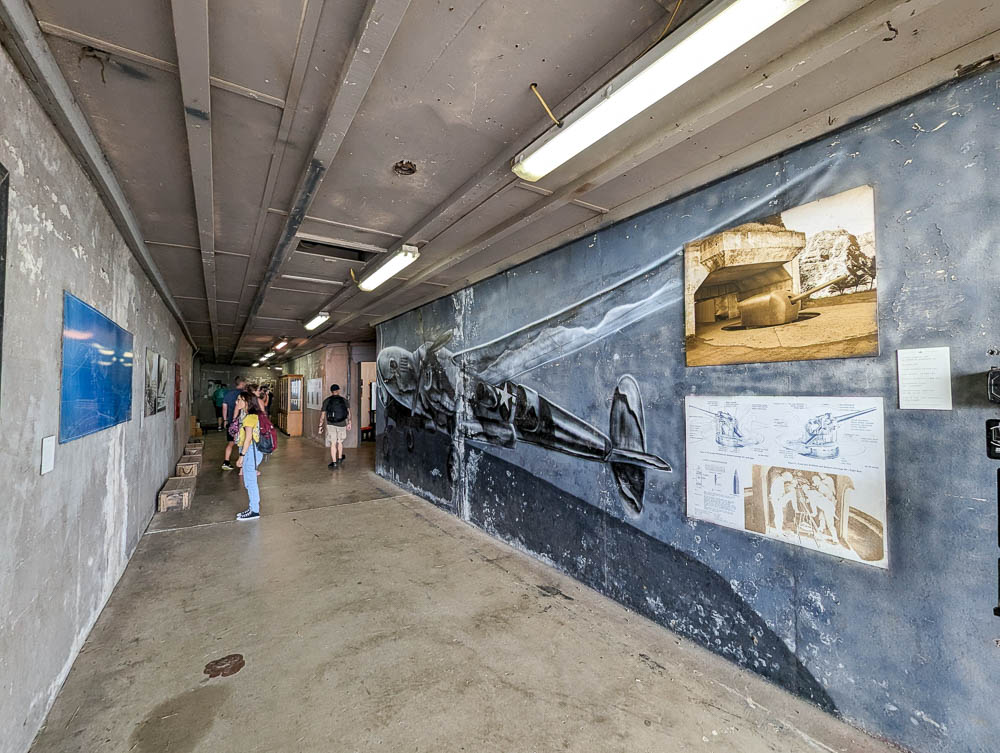
Oahu WWII sites: Pillboxes and other war-era ruins
Besides all the ways the war’s events have been memorialized around the island, some of the most interesting WWII sites on Oahu are the actual remnants themselves. All over Oahu you can find pillboxes, batteries, and other war-era ruins to explore. Here are a few of the many:
20. WWII bunkers at Kualoa Ranch
If you have plans to visit Kualoa Ranch for say, a Jurassic Park tour or other movie sites tour, you’ll be pleased to know that a visit to a WWII bunker is in your future! In fact, it’s one of the highlights.
Once aboard your tour vehicle, you’ll drive through the forest to get to the valley, the likes of which are full of mostly hidden WWII bunkers. My tour guide made sure to point these out to us and give us a lot of background information on how Kualoa Ranch was utilized during World War II.
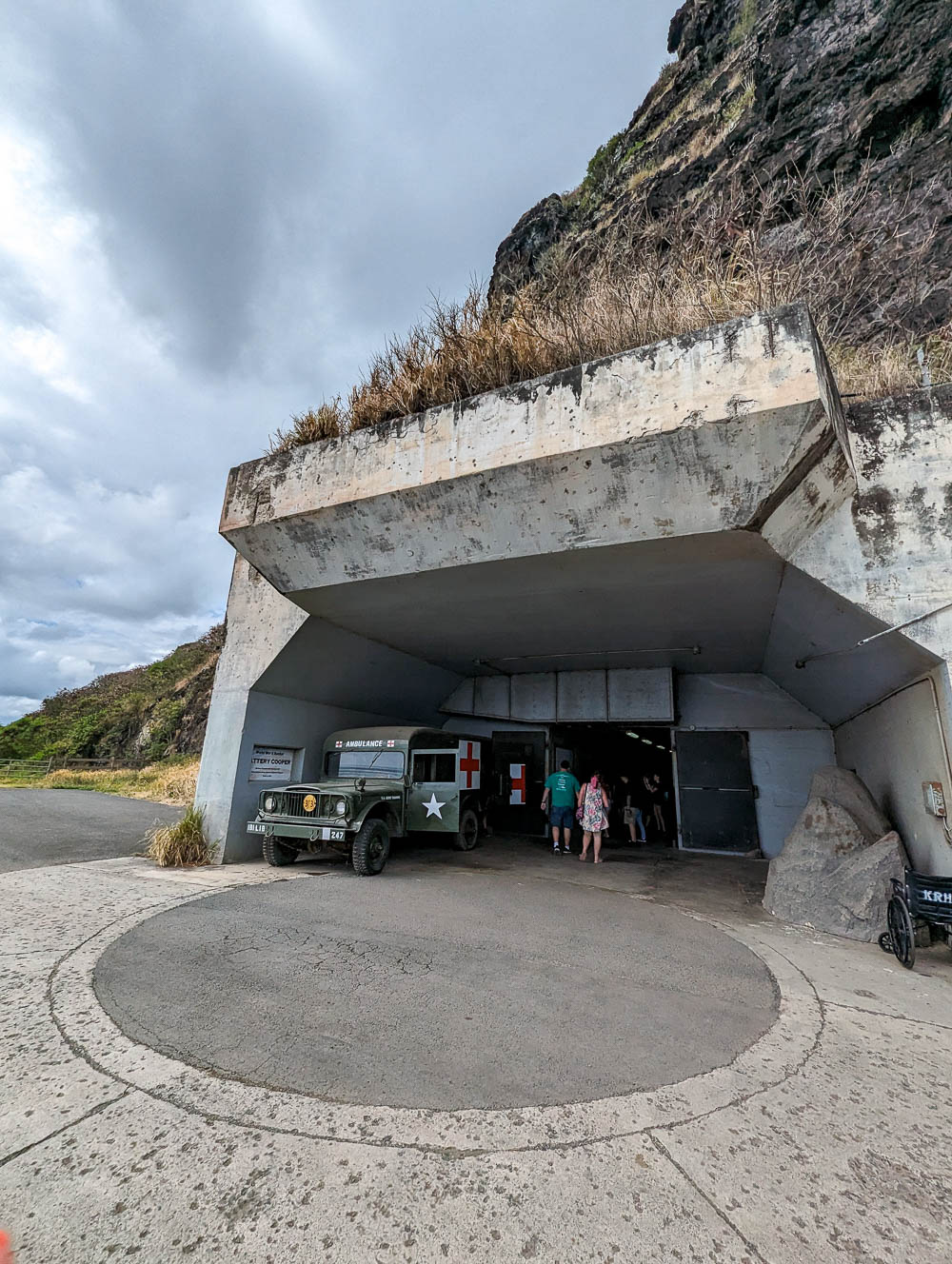
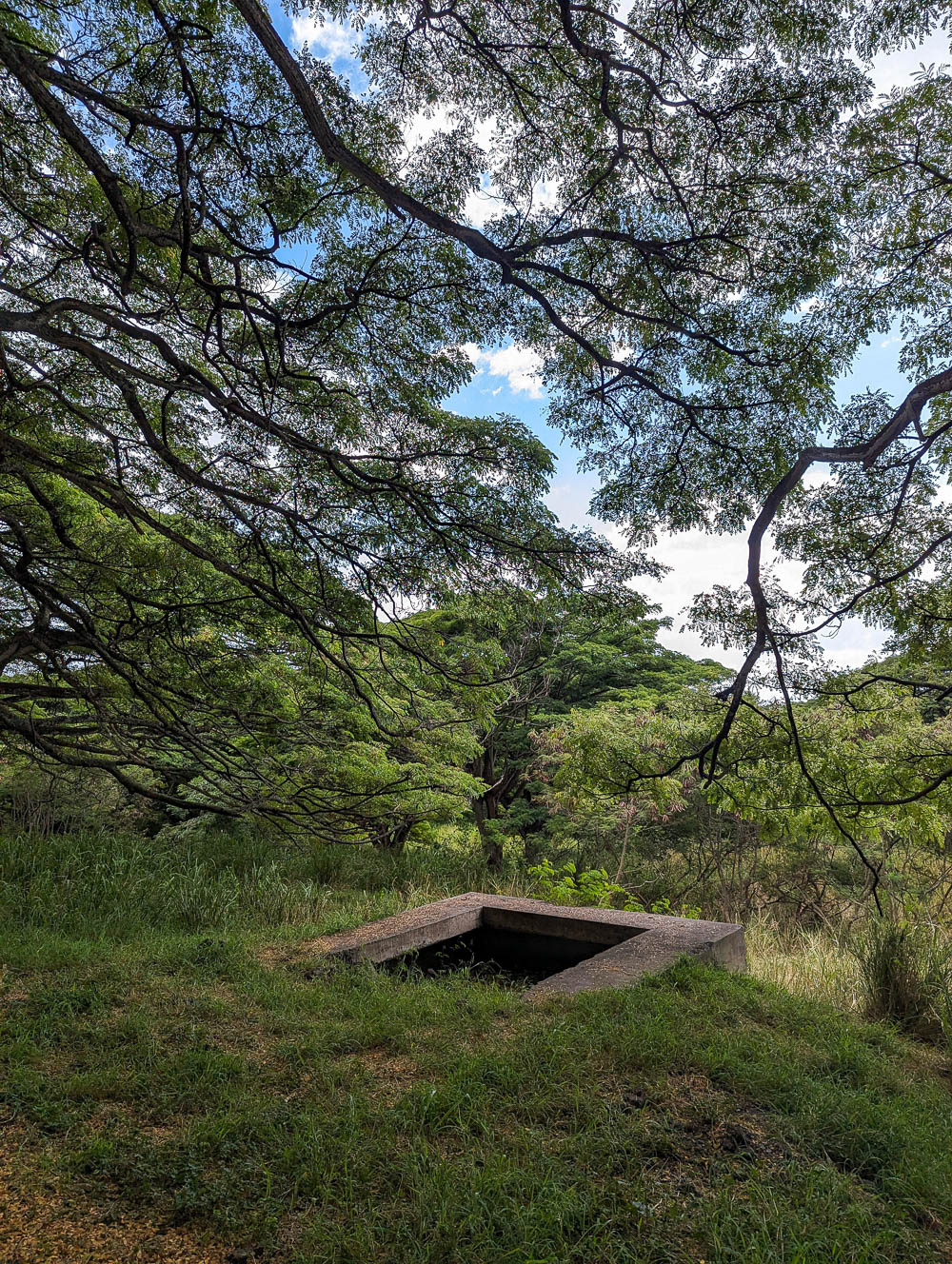
The first stop on your tour is going to be Battery Cooper. This former WWII bunker has since been used as a movie set and is now a museum of sorts, filled with tons of former sets and movie memorabilia.
They bring you here to check out the movie props, but the interior of the building is full of war history. There are several informative posters and archival photos on the walls that detail how Battery Cooper (and others at Kualoa Ranch) was used during the war. The movie props are meh, but the war history is an awesome and unexpected surprise.
You can check out all of the available Kualoa Ranch tours here on Viator and here on Get Your Guide. I personally took the Jurassic Adventure Tour since I’m a huge dino dork.
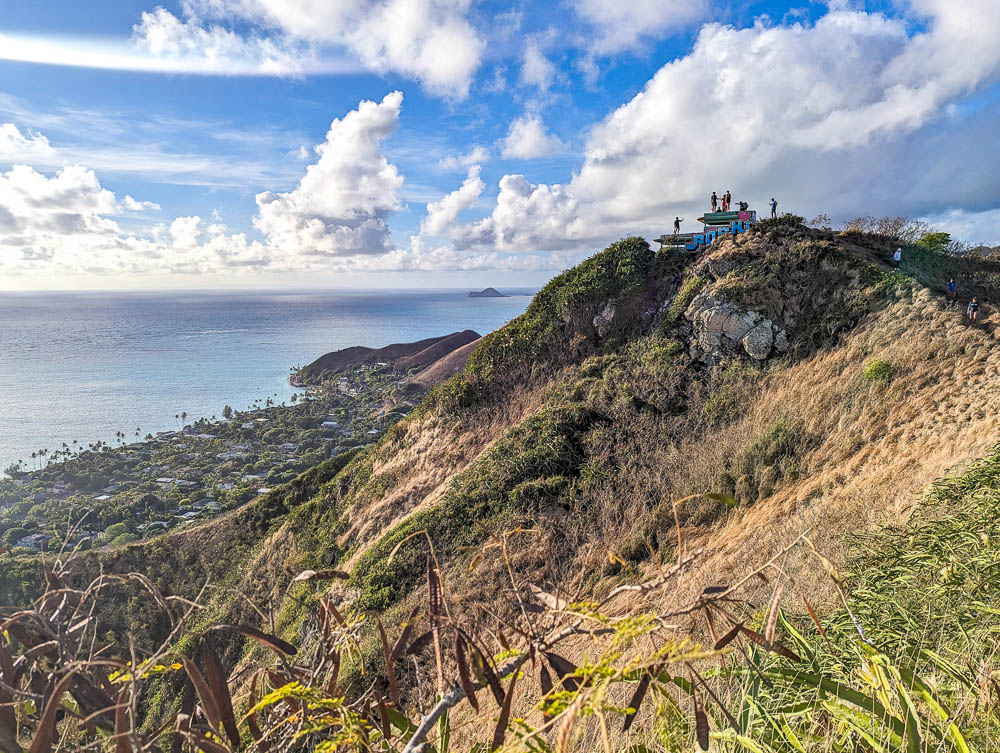
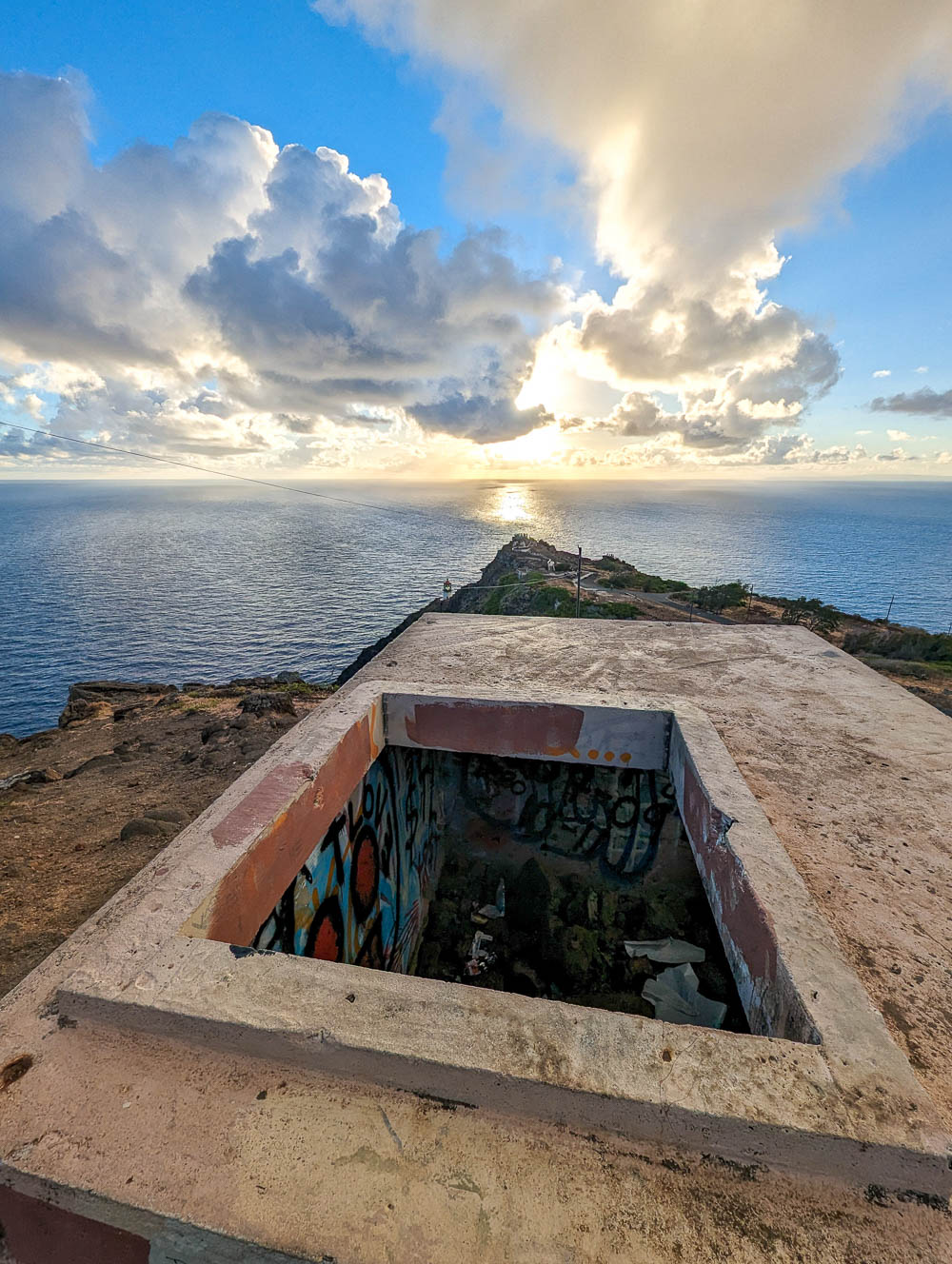
21. Pillboxes, bunkers, batteries
To see some of the neatest WWII sites on Oahu, you might have to do a little bit of hiking. WWII-era pillboxes, batteries, and bunkers abound on this island and to try and name them all would be nearly impossible.
But, I was able to get to a handful of them on my latest visit to Hawaii. If you can, check out these most popular and most easily accessible WWII pillboxes:
- Lanikai pillbox
- Peace pillbox
- Makapu’u Point pillboxes
- Diamond Head pillboxes
- Pink pillbox
For more on hiking to these awesome WWII pillboxes, you can check out my guide to WWII hikes on Oahu here or click the links for each of the above.


22. The Koko Head Railway
If you read my WWII hiking guide mentioned above, you’ll already know about this one, the craziest hike of them all—the Koko Head Railway.
The Koko Head Railway is a former railroad track the U.S. Army built up the side of the Koko Head Crater to move materials, people, and supplies between their base at the bottom and the operations and defense installations at the top.
Today, the defense center is gone but the railway remains and is now a popular hiking and fitness trail. It consists of 1,048 railroad ties that climb nearly vertical up the side of the crater. I know that sounds daunting, but once at the top you have tons of WWII history to explore.
The leftover rusted remains of the gas-powered railway are still here. As are the bunkers and lots of other random equipment. Be careful around here (maybe get your tetanus shot before you fly to Hawaii?) but do make the trip up if you can! More information about hiking the Koko Head Crater trail here.
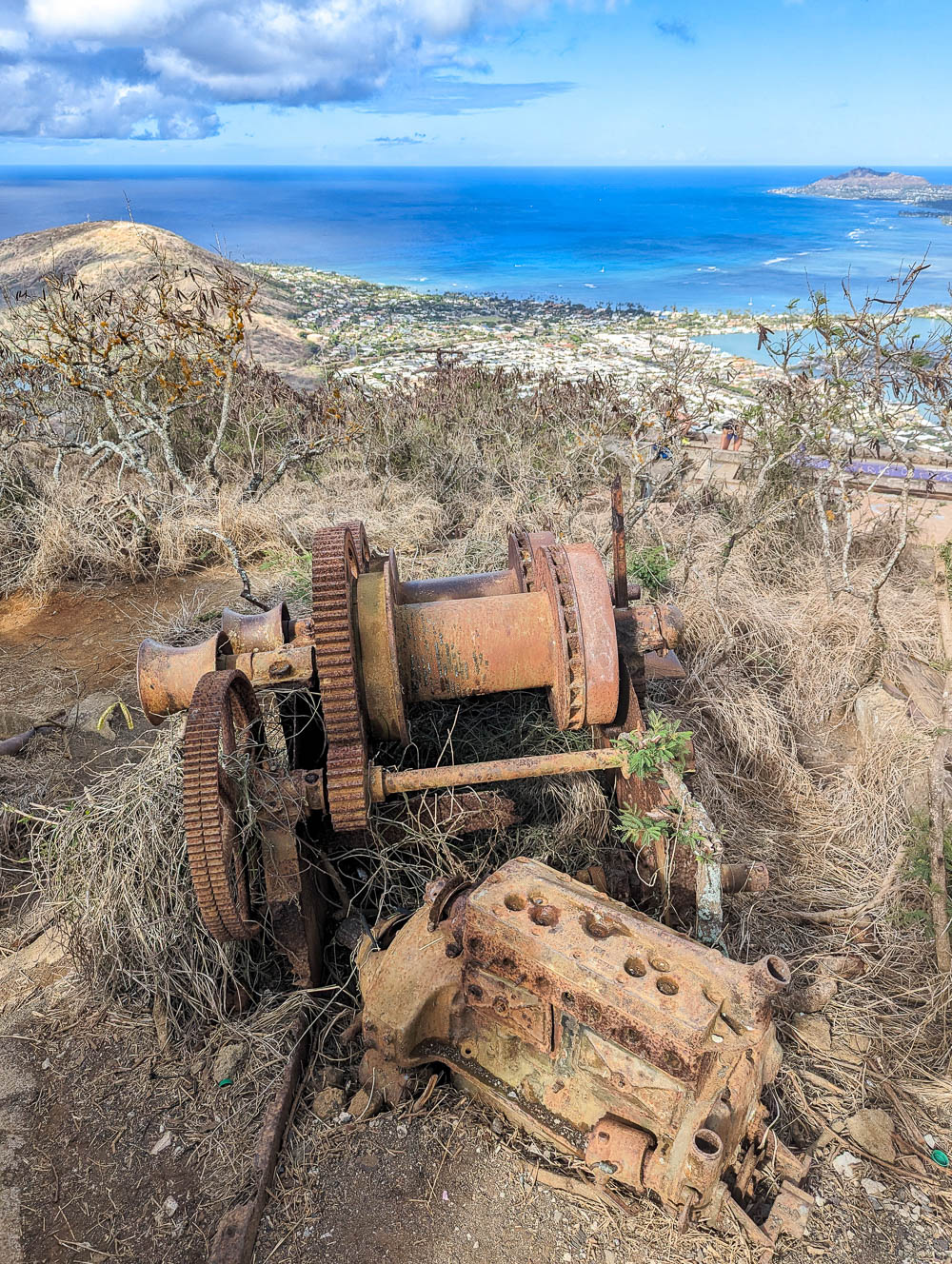
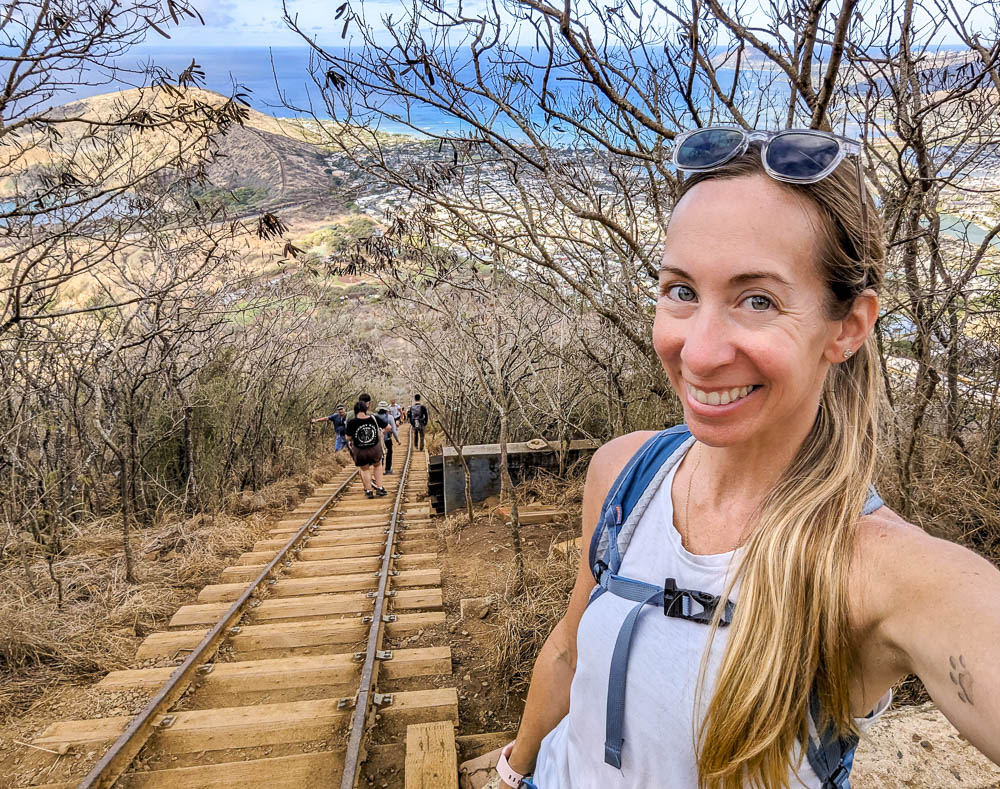
23. Corsair plane crash site
If you have scuba diving plans for your Hawaii trip, be sure to check out one of the most unique of the WWII sites on Oahu—the underwater crash site of a WWII Vought F4U Corsair plane.
Located about three miles off the southeastern shore of Oahu, this WWII plane sits at a depth of 110 feet below the surface. The plane is pretty well intact and is said to be a playground for large eels, rays, octopuses, a curious WWII buffs. If you’d like to see it for yourself, contact your preferred dive shop.
The plane made an unplanned water landing after running out of fuel, shortly after the end of the war. The pilot survived the crash, made it safely to shore, and lived happily ever after.
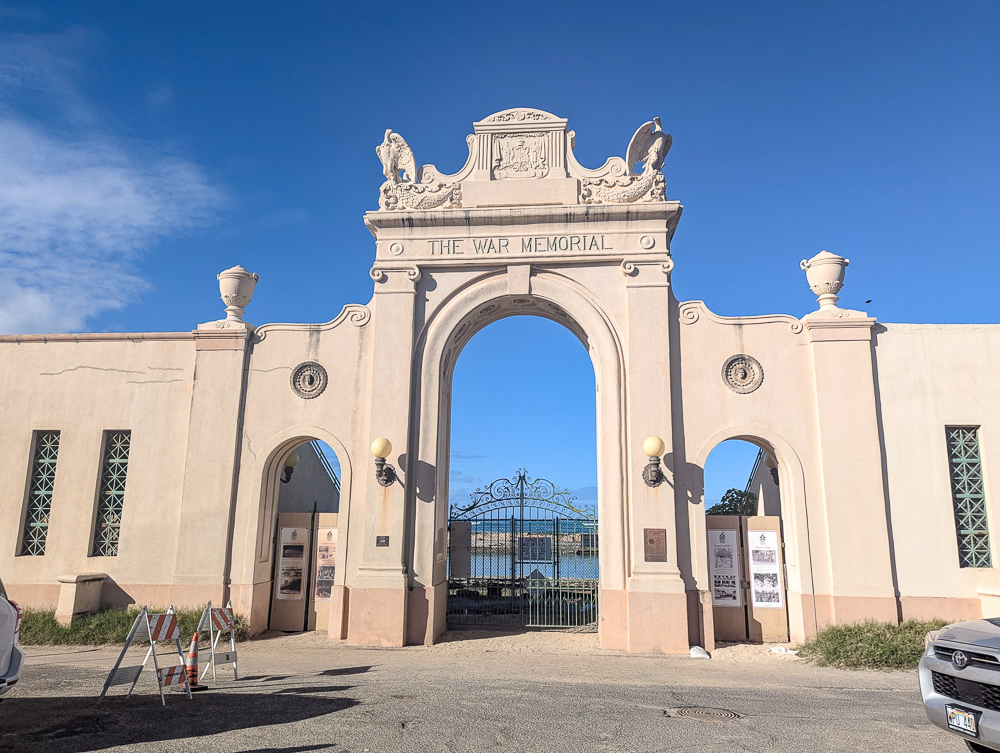
24. War Memorial Natatorium – Honorable Mention
I’ve listed the War Memorial Natatorium as an Honorable Mention for a couple of reasons. First, this is actually a World War I memorial. Also, because you can’t go inside so what you can actually see is limited. However, it’s still an interesting spot.
The War Memorial Natatorium in Waikiki originally opened in 1921 as a war memorial to honor those native Hawaiians who died serving in WWI. It consisted of a large public swimming pool that also held competitions. During WWII, the US Army commandered it for training purposes.
Today, the Natatorium sits in a state of disrepair while the state tries to figure out what to do with it. The site is fenced in but still contains a number of informational displays on the memorial’s history and key moments.
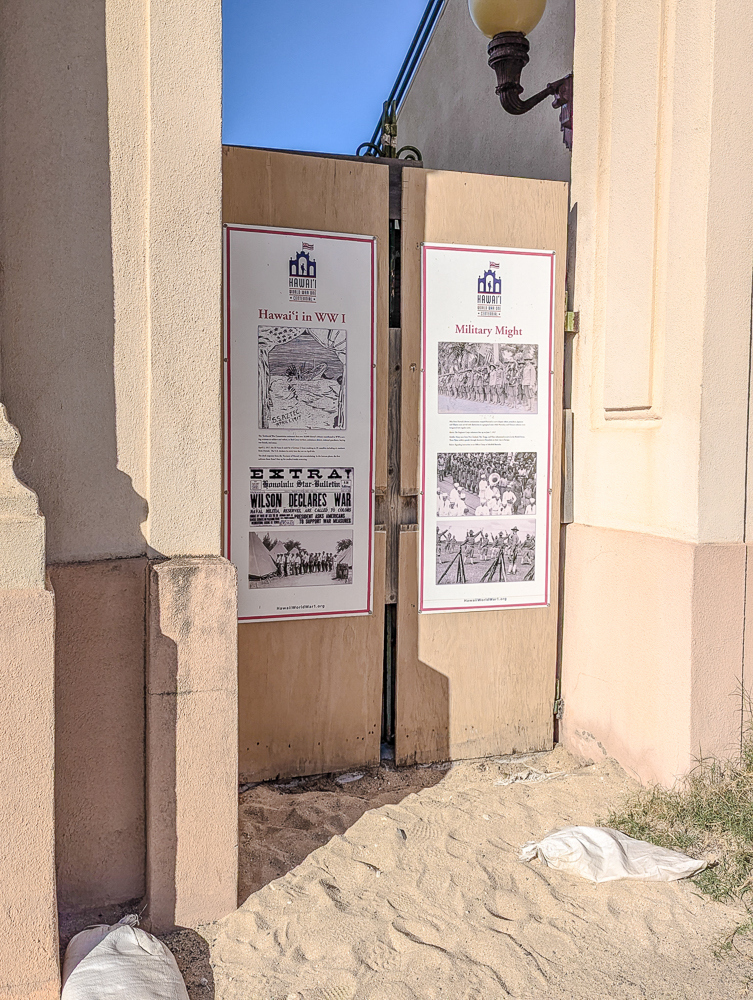
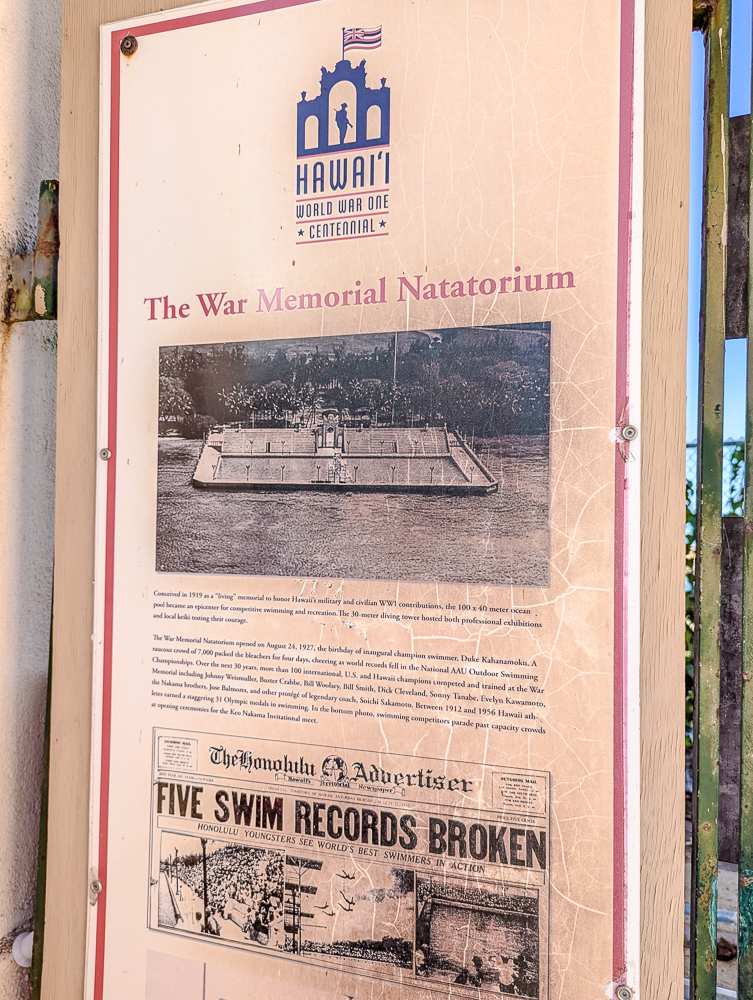
WWII sites on Oahu you need military access to visit
The following is a list of WWII sites on Oahu you need military access in order to visit. As a civilian, you can’t visit these on your own, but you can as long as you have a military chaperone (like I did).
- Ford Island Historical Trail
- USS Utah Memorial
- Pacific War Memorial

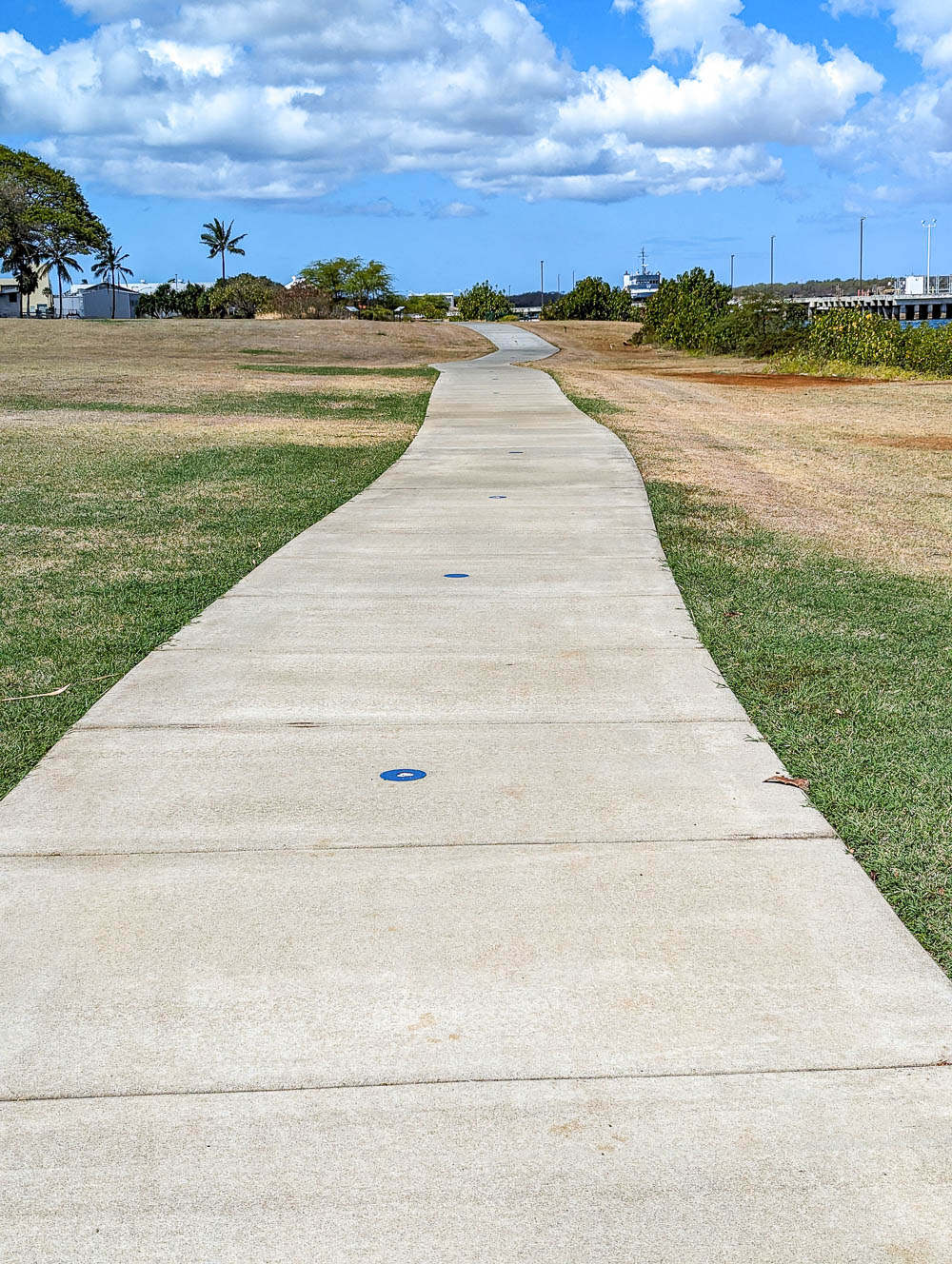
There is one exception to this however. Even though Ford Island in general is off-limits to non-military personnel, you can still visit as a civilian under one condition. If you’d like to see the USS Utah Memorial and the other cool WWII sites on Oahu along the Ford Island Historical Trail, you can book yourself a spot on the Ford Island Bus Tour.
This is a free tour provided by the National Park Service and is available to everyone, regardless of military access. Get more information about the Ford Island Bus Tour here.
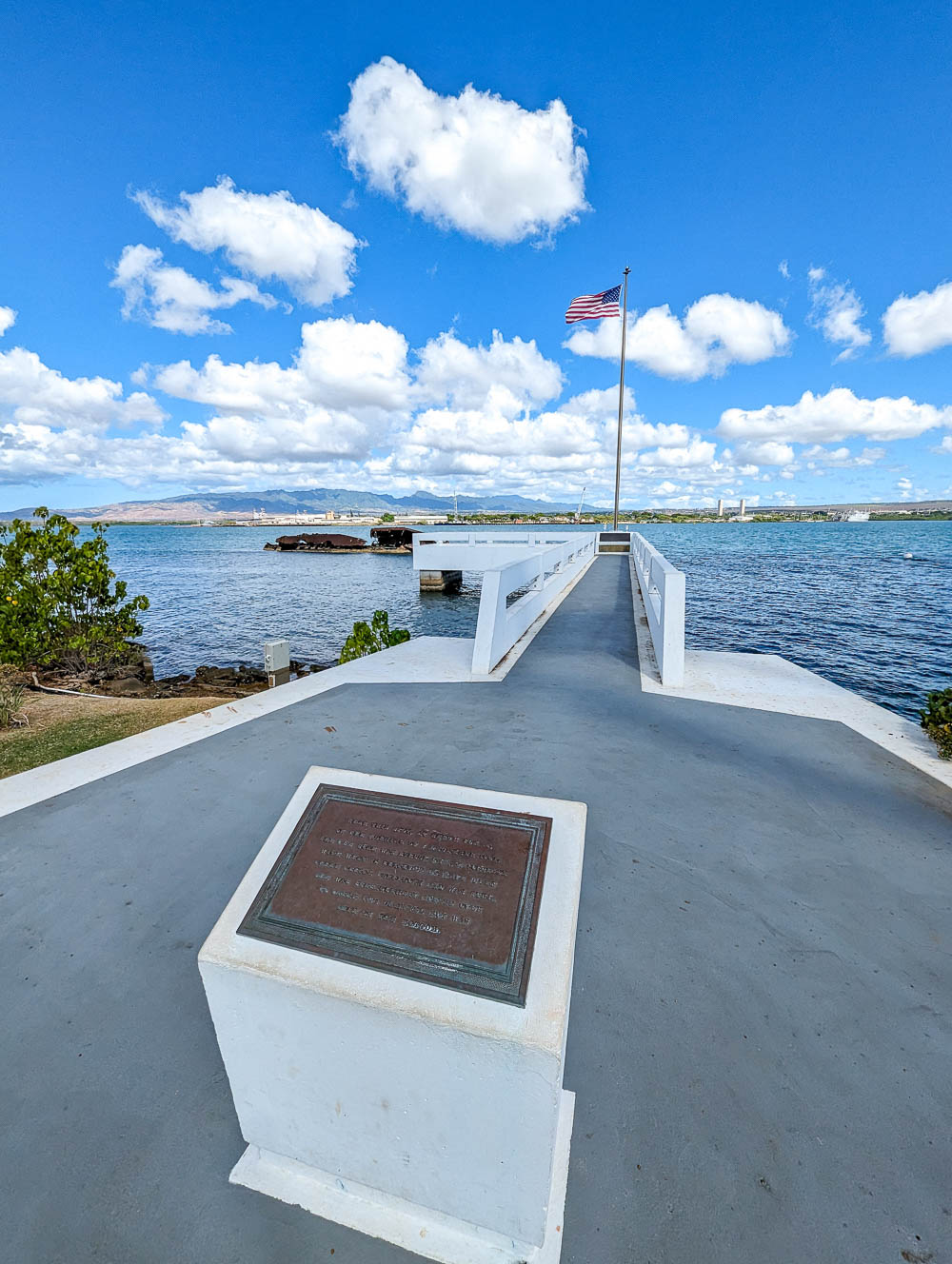
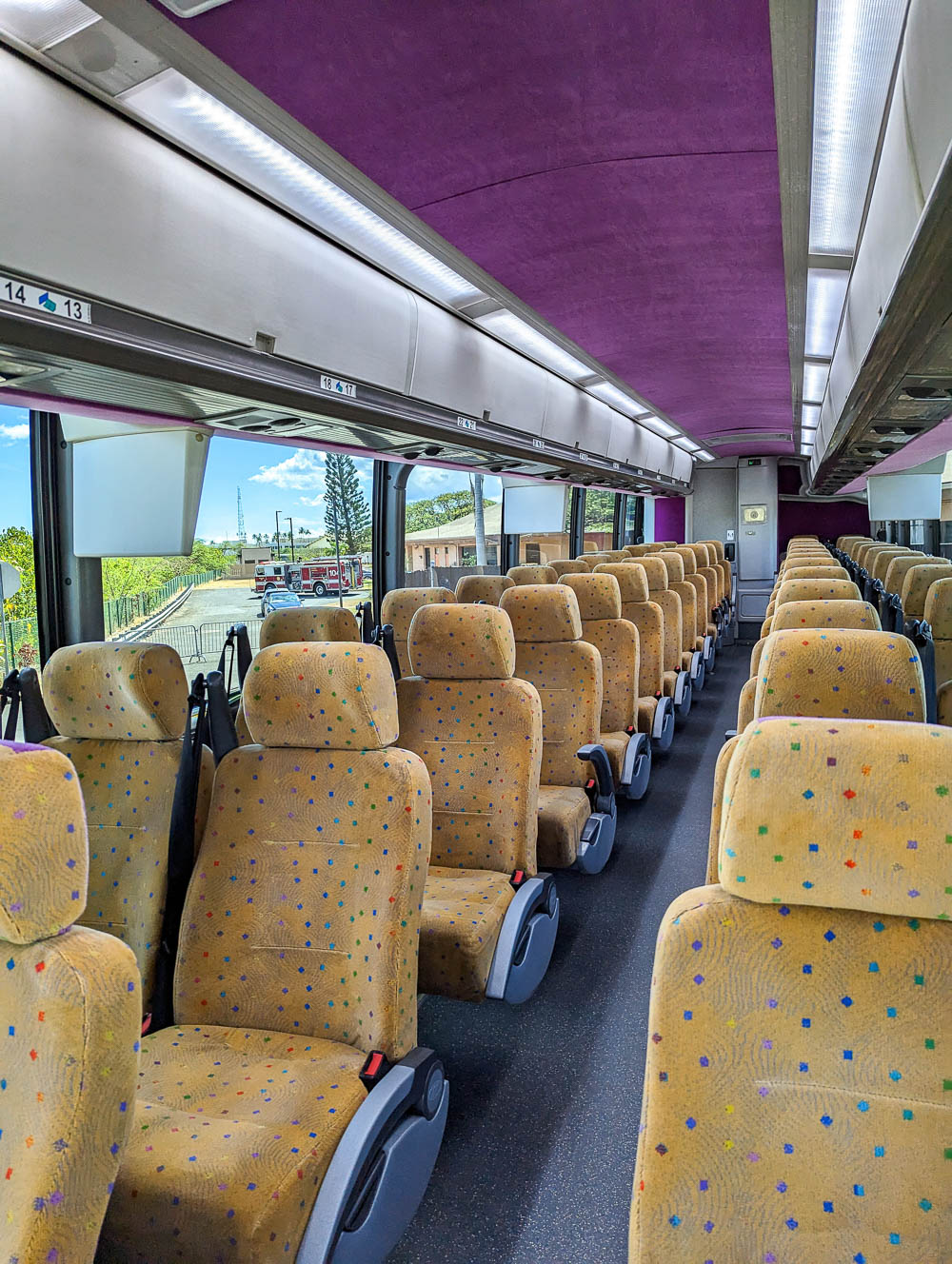
To visit the other WWII sites on Ford Island without military access—the Battleship Missouri, the Pearl Harbor Aviation Museum, and the USS Oklahoma Memorial—you can and must take the free shuttle bus from the Pearl Harbor Visitor Center. If you do have military access, you can drive yourself to these sites and park for free.
For all your other Oahu sightseeing, pick up a GoCity Pass to save tons of money.
More info for your trip to the WWII sites on Oahu
- Hotels: Read reviews and book your room here on Booking.com (But Hotels.com and Expedia usually have good deals too.) VRBO is best for vacation rentals.
- Rental car: Check out the best rental car deals on Oahu here so you can drive yourself to all these sites.
- Sightseeing: Pick up your Oahu GoCity pass here to potentially save lots of money.
- Trip planning: Don’t forget to pick up a Hawaii guidebook for the rest of your trip and this pocket size USA customs and culture guide if you’re coming to us from abroad.
- More Hawaii: Check out all my Hawaii blog posts here.
Like this post? Have questions about visiting the WWII sites on Oahu? Let me know in the comments below. Have fun in Hawaii!
Save this info, pin this image:
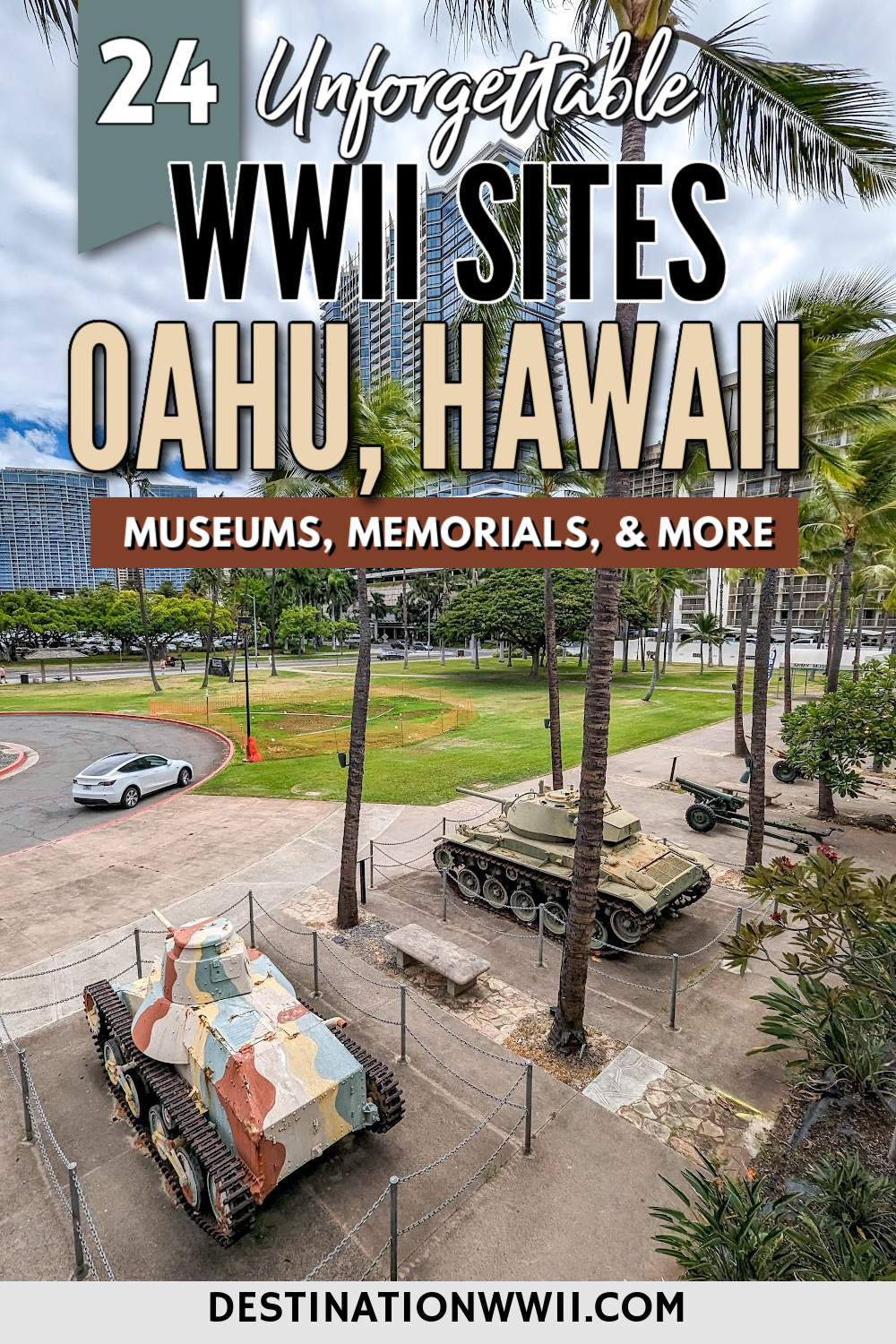
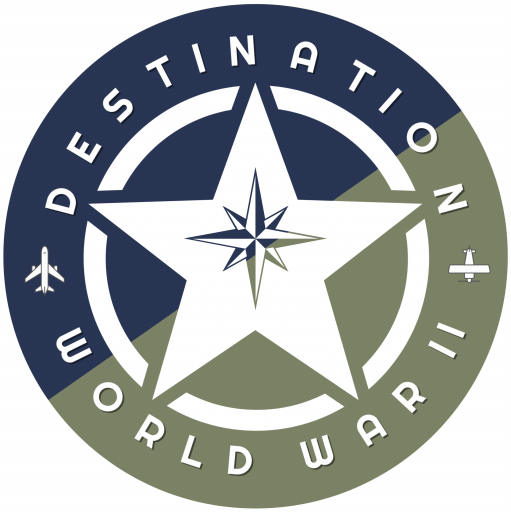
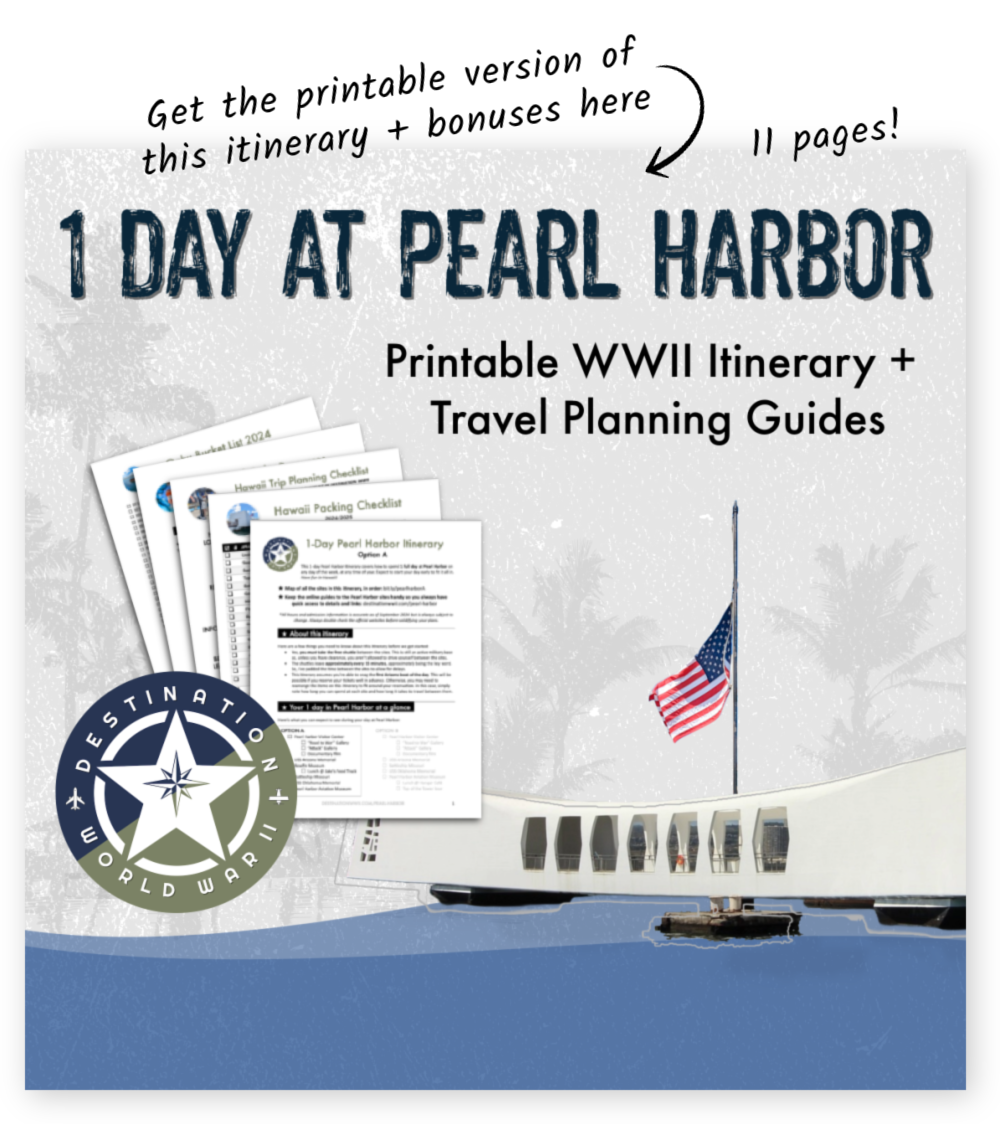
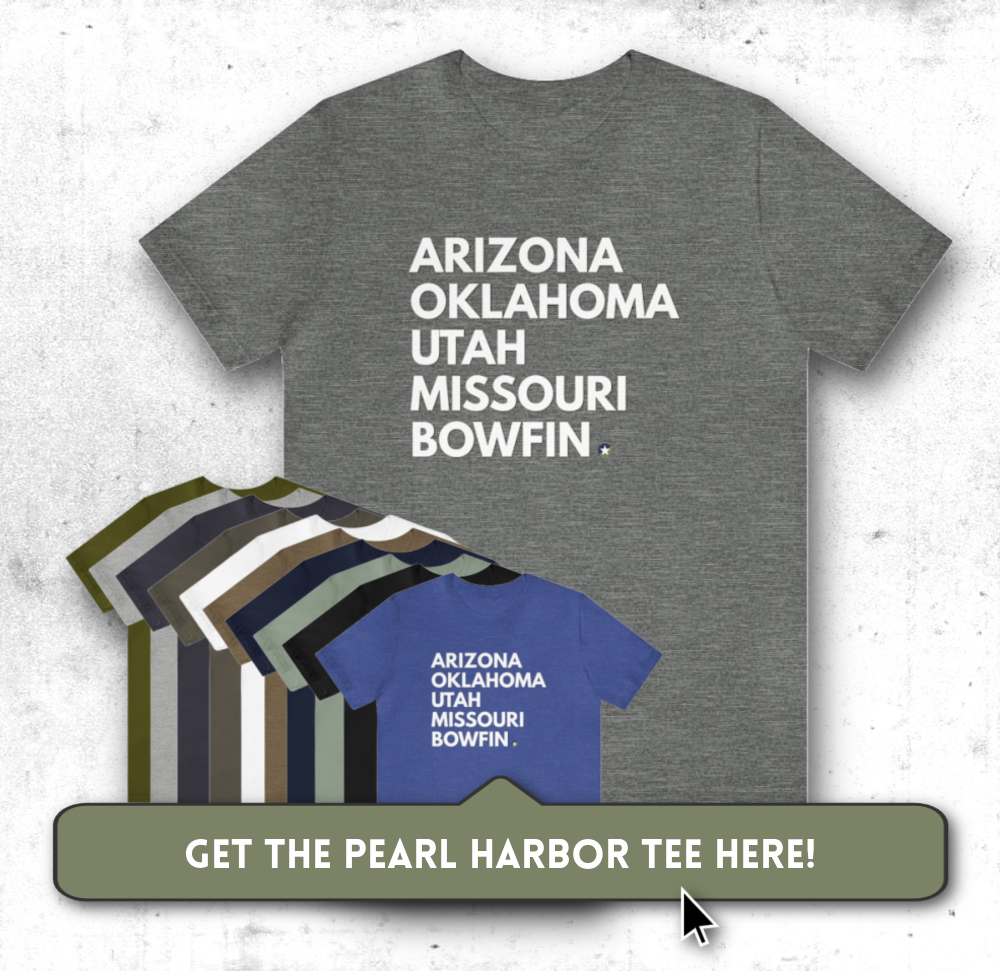

This is a great tour. I was stationed at Fort Shafter in 1970 at the watch office that was first alerted about the Japanese Pearl Harbor invastion….the occupants of the wire cage were the ones notifying the Army Captain that a pending attack was in motion…..
Ed Haley
Atlanta, GA
That’s so interesting, Ed! What an experience.